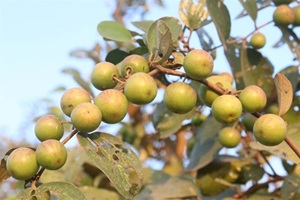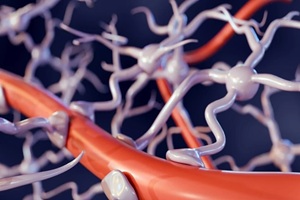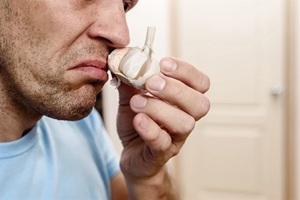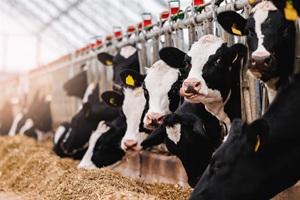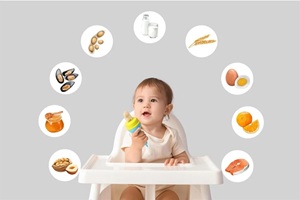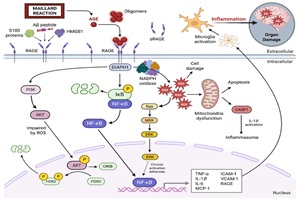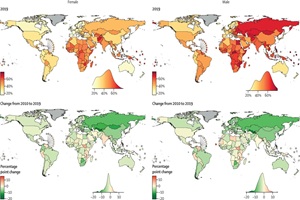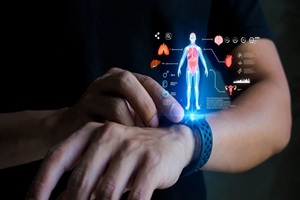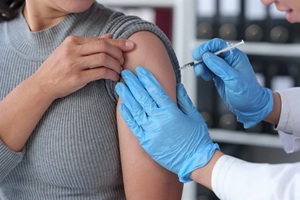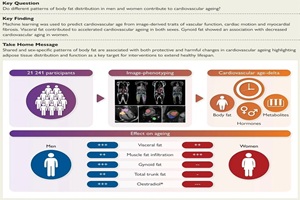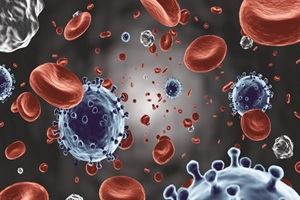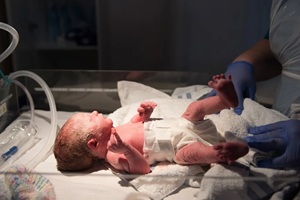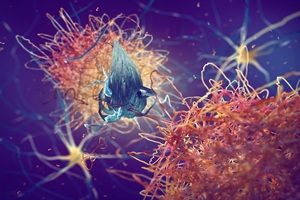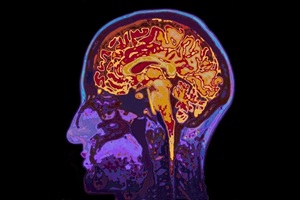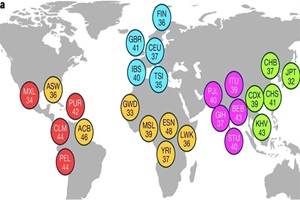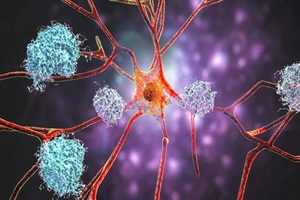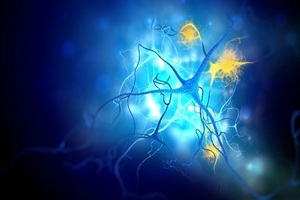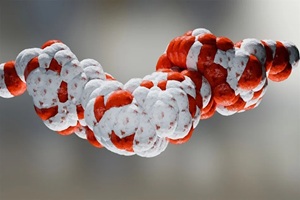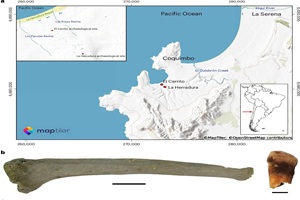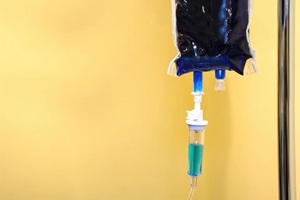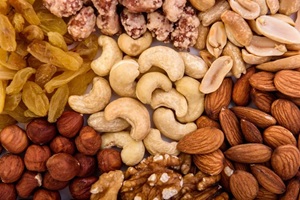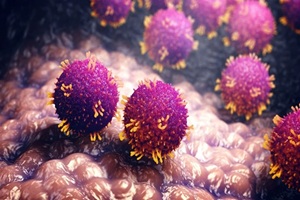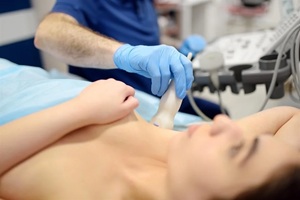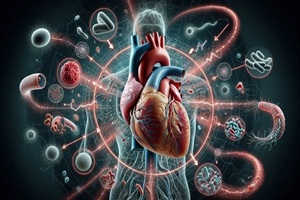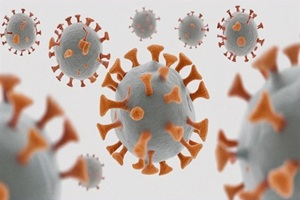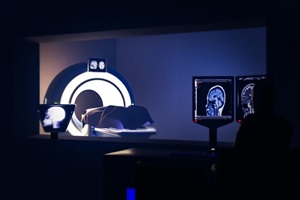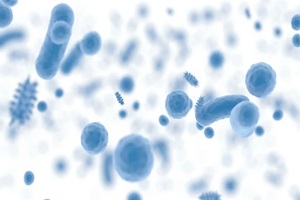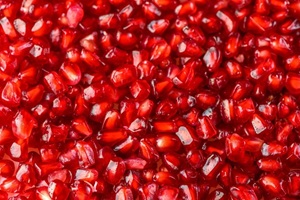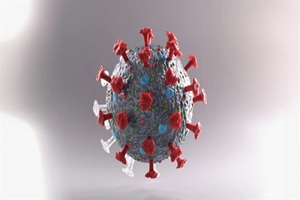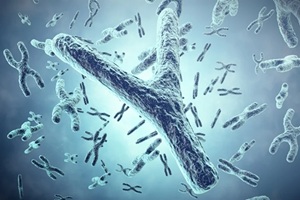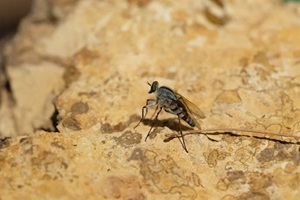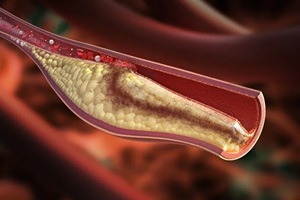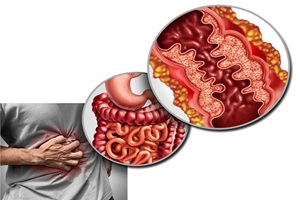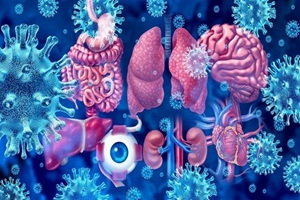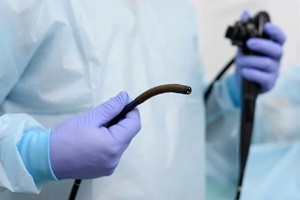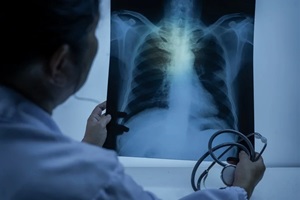- Home
- News & Media Coverage
News and media
Researchers leveraged a "natural experiment"post-war 1950s UK sugar rationing to explore the long-term cardiovascular impacts of early-life nutrition.
Researchers evaluated the antimicrobial potential of parts of a tropical fruit tree, Ziziphus mauritiana. Z. mauritiana, known as Bidara in Malaysia, is a tropical fruit tree capable of growing up to 15 meters and has a robust trunk, glossy green leaves with paler undersides, and distinctive drooping branches with spines.
Researchers investigated whether new public health guidelines (2015 and 2017) issued in the United States (US), specifically those recommending the early introduction of peanuts in childhood diets, were associated with changed real-world rates of food allergies in children.
Researchers elucidated the structure and function of the blood-brain barrier (BBB).
Researchers investigated the structural integrity and connectivity of white matter pathways in olfactory-related brain regions in patients with post-coronavirus disease 2019 (COVID-19) olfactory dysfunction (OD).
Nurses commonly wear nonsterile gloves while preparing antimicrobial injections for intravenous use and giving these shots to patients.
A new study published reveals that highly pathogenic avian influenza virus can remain infectious for up to 120 days under certain pH conditions in raw-milk cheese producedcontaminated milk.
In a recent reportthe AMR Division of the World Health Organization (WHO), scientists discussed the results of a global effort to monitor antibiotic resistance.
Researchers investigated associations between sociodemographicacteristics and eating disorder (ED) symptoms in adolescents.
Researchers in the United States investigated associations between cumulative social advantage (CSA) and epigenetic aging, neuroendocrine function, and systemic inflammation.
Researchers conducted a retrospective study to identify allergy risks (primarilycow's milk and hen's egg) associated with oral food challenges (OFCs).
A recent study published utilized metabolomics to investigate the mechanisms underlying the association between food additives and childhood asthma.
A recent study used dataparticipantssleep clinics to assess the performance of a consumer-grade sleep-tracking device, relative to polysomnography (PSG).
Variants of the severe acute respiratory syndrome coronavirus 2 (SARS-CoV-2), the virus responsible for the coronavirus disease 2019 (COVID-19) pandemic, continue to emerge almost six years after its initial emergence.
Researchers examined how elderberry juice (EBJ) alters transcriptional response to feeding and fasting.
An international team of researchers conducted a comprehensive multiomics analysis of the world’s oldest living person and compared her data with matched cohorts.
Researchers investigated the specific role of extra-virgin olive oil (EVOO), a key component of the Mediterranean diet, in its association with abdominal obesity.
Researchers examined how dietary sources and food preparation methods contribute to signaling pathways associated with neurodegenerative illness.
Researchers conducted an extensive prospective cohort study leveraging datamore than 182,000 UK adults to elucidate the relative associations between the world's three most popular beverages, tea, coffee, and water, and subsequent mortality risk.
A new study published reports that changes in external eating behavior may influence the glucose-lowering and body weight management efficacy of glucagon-like peptide-1 receptor agonists in type 2 diabetic patients.
Airborne allergens, or aeroallergens, can cause respiratory allergies and asthma.
During the coronavirus disease 2019 (COVID-19) pandemic, multiple families got puppies, mainly to help them with their mental health.
Wheat bread has been a central part of the human diet for centuries.
Researchers developed a machine learning model that utilized large-scale health data to predict the progression of 1,256 distinct ICD-10 level 3 diseases based on patients' past medical histories.
An international team of researchers evaluated the efficacy and safety of once-daily oral orforglipron versus placebo over 72 weeks in adults with obesity without diabetes mellitus.
Researchers investigated whether Tai Chi can enhance the cognitive functioning of older adults with type 2 diabetes compared to that achieved through usual care or fitness walking.
A group of researchers quantified the changes in non-communicable disease (NCD) mortality2010 to 2019 across 185 countries, attributing these changes to specific causes and age groups compared with the period2001 to 2010.
Researchers investigated the links between the duration of daily eating windows and mortalityvarious causes among American adults.
A recent review published compares the different health parameters measured by common wearable sensors used by consumers and provides evidence of their accuracy, validity, regulatory clearance status, and practical issues.
A recent reportthe National Center for Health Statistics used NHANES data to estimate the share of daily caloriesfast food among American adults.
Researchers investigated how tetrahydrocannabinol (THC), the main psychoactive compound found in cannabis, affects women’s fertility.
Researchers Robert B. Hamanaka and Gökhan M. Mutlu at The University of Chicago, USA, synthesized toxicological studies and epidemiological evidence to explain how particulate matter (PM) causes impaired lung function, inflammation, and oxidative stress, thereby contributing to both chronic and acute respiratory illnesses.
A group of researchers synthesized and quantified concentrations of core human milk oligosaccharides (HMOs) at 12 months and beyond and examined temporal patterns across lactation.
A recent review examined how growing cereals and pseudocereals such as amaranth, quinoa, sorghum, and wheat at the microgreen stage, termed microgreening, affects their properties.
The “unhappiness hump” is a well-documented global trend of increasing unhappiness with aging that peaks in middle age and declines thereafter.
Romantic breakups are extremely common in adolescence and early childhood, but leave behind emotional scars.
A recent paper explores how artificial intelligence could help better matches among flu vaccine candidates.
Researchers analyzed the seroprevalence of Toxoplasma gondii in Europe.
Chewing gum is extremely popular.
Researchers in Germany investigated whether specific markers of ultra-processing (MUPs) are associated with mortality, beyond the established links between ultra-processed foods (UPFs) and poor health.
Exercise and a balanced and nutritious diet are key to a healthy lifestyle.
Researchers investigated how different patterns of body fat distribution influence cardiovascular aging by gathering datamore than 20,000 individuals.
An international team of researchers assessed adherence to the Mediterranean Diet (MedDiet) and related lifestyle behaviors using the Mediterranean lifestyle (MedLife) Index, and examined gender-specific associations with physical activity, sleep, mental health, social participation, and perceived barriers.
Researchers examined how coronavirus disease 2019 (COVID-19) vaccination successes coincided with rising hesitancy, quantified links between baseline acceptance and booster uptake, and outlined evidence-based strategies to restore confidence.
A study published revealed that coronavirus disease 2019 (COVID-19) can increase arterial stiffness and accelerate vascular aging, especially in women.
The authors examined how coronavirus disease 2019 (COVID-19) may accelerate vascular aging and its implications for long-term care.
An International team of researchers showed that respiratory viral infections awaken dormant breast cancer cells in the lungs.
Researchers in the United Kingdom analyzed more than a decade's national dietary data to quantify the dietary overlap between explicitly regulated HFSSs and UPFs that are indirectly covered under HFSS rules in the United Kingdom (UK).
Unsweetened tea consumption significantly lowers the risk of all-cause mortality, cancer, and cardiovascular diseases (CVD) compared to sugar-sweetened and artificially sweetened tea.
Researchers investigated the relationship between the intake of minerals such as calcium, zinc, and iron, and the incidence of depression among adults in the United States and Korea.
Researchers assessed the levels of microplastics (MPs) that people are exposed to through their daily intake of fluids using survey data and laboratory analysis in the UK.
A study investigated the safety and efficacy of high doses of vitamin D supplementation in very low birth weight (VLBW) preterm infants.
Researchers in the United States investigated how naturally occurring lithium in the brain is regulated and whether it plays a role in protecting against cognitive decline and Alzheimer’s disease.
The immune system detects and responds to the presence of a pathogen to eliminate or counteract its toxic effects.
Researchers discussed findingsa randomized controlled trial (RCT) that compared the effects of diets high in ultra-processed foods (UPF) with those of diets high in minimally processed foods (MPF) on changes in weight among adults with obesity or overweight.
Researchers in Germany and the Netherlands explored the links between impulsivity in adults without diagnosed mental disorders and the diet and gut microbiome.
Researchers collated and synthesized literature to define the "flexitarian" dietary pattern.
An international team of researchers reassessed the arbitrary 10,000 daily step goal that has served as the unofficial ‘healthy’ for decades.
Researchers investigated the association between different levels of tea and coffee consumption and long-term changes in cognitive performance among older adults.
A group of researchers tested whether prenatal phthalate metabolites, individually and as a mixture, forecast preschool Full Scale Intelligence Quotient (FSIQ), Performance Intelligence Quotient (PIQ), and Verbal Intelligence Quotient (VIQ), and whether these links vary by child sex and specific cognitive domains.
Researchers reconstructed historical dietary habits using proteomic and stable isotope analyses.
Kombucha is a sweetened tea fermented by a symbiotic culture of bacteria and yeast (SCOBY).
Researchers investigated large-scale structural variants (SVs), complex and poorly understood insertions, deletions, and rearrangements in DNA, using next-generation 'long-read' sequencing.
A group of researchers tested whether the coronavirus disease 2019v (COVID-19) pandemic, with or without severe acute respiratory syndrome coronavirus 2 (SARS-CoV-2) infection, accelerated biological brain aging in middle-aged and older adults.
A group of researchers investigated whether combining the aromatase inhibitor letrozole and the topoisomerase I inhibitor irinotecan could reverse cell–type–specific transcriptomic disturbances and improve cognition and pathology in Alzheimer’s disease (AD) models.
Researchers identified a conserved immune signature associated with the apolipoprotein E ε4 variant (APOE ε4) across cerebrospinal fluid (CSF), brain, and plasma, regardless of the presence of neurodegenerative disease.
Researchers assessed associations between the dietary index for gut microbiota (DI-GM) and phenotypic age acceleration (PAA).
A recent paper explored how maternal age, delivery type, and infant sex affect mothers' milk production and nutritional content after premature birth.
A group of researchers evaluated the association between maternal first-trimester messenger ribonucleic acid (mRNA) coronavirus disease 2019 (COVID-19) vaccination and the risk of congenital malformations.
Childhood cancer survivors have a substantially higher risk of developing severe coronavirus disease 2019 (COVID-19) even many years after their cancer diagnosis.
A group of researchers tested whether intranasal allergen-specific immunoglobulin G1 (IgG1) monoclonal antibody (mAb) prevents mugwort pollen-induced allergic rhinitis and lower-airway inflammation in sensitized mice.
Researchers in Switzerland examined the impacts of consuming ultra-processed foods (UPFs) on brain function and development during the critical periods of childhood, adolescence, and pregnancy.
Researchers utilized next-generation assays to investigate the regulatory factors, cell types, and molecular events involved in human adipose tissue (AT) remodeling.
University of California, Los Angeles researchers identified four distinct pathways leading to Alzheimer’s disease.
A group of researchers ranked the glycemic, weight, cardiovascular, and safety outcomes of eight Glucagon-Like Peptide-1 Receptor Agonists (GLP-1 RAs) versus placebo and standard antidiabetic drugs in adults with Type II Diabetes Mellitus (T2DM) using a Bayesian network meta-analysis.
A group of researchers determined whether decades of regular cannabis smoking create distinct, reversible deoxyribonucleic acid (DNA) methylation marks in mid-life adults.
Artificial intelligence (AI) is a revolutionary blend of computing technologies that could transform humanitarian healthcare by developing novel solutions to crises.
Engaging in physical activity for over 150 minutes per week can significantly reduce the progressionprediabetes to type 2 diabetes.
Researchers in Chicago, USA, investigated whether adopting a Mediterranean Diet (Med Diet) lifestyle, with or without calorie-restricted weight loss, improves cognition and cardiometabolic health over a 14-month period.
Researchers analyzed Mycobacterium lepromatosis genomes4,000-year-old human remains, revealing a long history of leprosy in the Americas.
Researchers discussed the impacts of human activities on microbial ecosystems, arguing for the urgent need to preserve microbial diversity for human and environmental health.
India is a vast country with a remarkably diverse population, comprising approximately 5,000 groups defined by their religious, ethnic, and linguisticacteristics. Yet, historically, it has been underrepresented in genomic surveys.
Methylene blue is an aromatic compound used to treat methemoglobinemia, a rare blood condition that affects the oxygen-carrying capacity of red blood cells.
Among other measures for a healthy lifestyle, omega-3 fatty acid supplements are popular due to their anti-inflammatory and antioxidant effects.
Social media constantly and persuasively target adolescents with online advertisements of food and drink, mostly for junk food.
Researchers investigated the factors that drive caregivers and parents in the United Kingdom to provide their young children with processed snack foods.
Researchers reviewed sex differences in the efficacy of the ketogenic diet (KD) for weight loss, revealing that men show significantly greater weight loss than women under identical KD protocols.
A systematic review and meta-analysis of clinical trials demonstrated that nut intake has only a modest impact on gut microbiota and overall gut health.
A group of researchers investigated the relationship between a composite Lifestyle Risk Factor Index (LSRI) and the incidence of type 2 diabetes mellitus (T2DM) in a multi-ethnic population.
Researchers described the current state of measles outbreaks, with a focus on the United States, and highlighted risk factors for the disease, as well as recommendations for public health policy and clinical practice.
Researchers investigated how lifestyle factors and environmental exposures affect the severity of motor symptoms in patients with Parkinson’s disease over time.
Breast cancer is the most common cancer and cause of cancer-related death in women.
Researchers demonstrated that phytochemicals and their microbiome-derived compounds regulate the anticancer activity of phosphatidylinositol 3-kinase (PI3K) inhibitors (PI3Ki).
Researchers examined associations between varying low-carbohydrate diet (LCD) patterns and changes in oxidative stress and inflammation biomarkers.
Researchers investigated the relationship between consuming poultry meat and the incidence of gastrointestinal cancers (GCs) and other causes of mortality.
A recent study published identifies a gut microbiota pattern that can predict the risk of new adverse cardiovascular events in patients with coronary heart disease (CHD).
A recent study determines the potential of measuring transmembrane serine protease 2 (TMPRSS2) and angiotensin-converting enzyme 2 (ACE2) levels in the nasal cavity to predict the risk of future coronavirus disease 2019 (COVID-19) and whether the host nasal microbiome modulates the expression of these proteins.
A recent study reviews the role of vitamin D in the development of colorectal cancer (CRC).
Psychedelics, a class of hallucinogenic drugs, may serve as a potential therapeutic intervention for some obese people who experience addictive-like overeating behaviors, recent research suggests.
A team of US-based researchers recently tested the safety and efficacy of a licensed avian influenza vaccine in protecting California condors, a critically endangered bird species, against the highly pathogenic avian influenza virus.
Researchers used a large (n = 25,898, age = 45–73 yrs) Swedish cohort to elucidate any relationships between the EAT-Lancet diet and dementia incidence.
A new study published reveals that the radiation dose currently used in routine computed tomography (CT) examinations in the United States is projected, using modeling, to eventually account for 5% ofnew cancer diagnoses annually.
Study evaluates the effects of a weight-loss lifestyle intervention on age-related bone deterioration.
Researchers at Gachon University, Republic of Korea, summarize more than 110 scientific publications to elucidate the role of the gut-brain axis in maintaining gastrointestinal health.
Food additives are everywhere these days, largely due to the surge in processed food consumption.
A team of researchers at McGill University and the University of Helsinki analyzed the UK Biobank data and found that high ultra-processed food intake is associated with adverse metabolic and adiposity profiles and changes in the microstructure of feeding-related brain regions.
In a recent perspective piece published, researchers at the University of Plymouth, UK, highlighted smoothies as an important source of plant-based nutrition.
Several studies have reported that the coronavirus disease 2019 (COVID-19) can lead to heart rate variability (HRV), with the intensity of these symptoms directly related to infection severity.
Chronic low-grade inflammation often increases with age—a phenomenon known as inflammaging. This process is linked to a higher risk of conditions such as diabetes mellitus, cardiovascular disease, and neurodegenerative disorders in older adults.
A recent study published investigates whether the use of hormonal contraception (HC) increases the risk of postpartum depression.
A recent study published assessed the presence of soy- and gluten-derived excipients in medicinal products authorized in Portugal.
Researchers collated and summarized more than 120 publications to elucidate the dual therapeutic and toxicological effects of nutraceuticals.
A study published describes the utility of caffeine and beetroot juice as performance enhancers.
Researchers at McMaster University, in collaboration with researchersthe University of Illinois at Chicago, have discovered a powerful candidate antibiotic that can kill a broad range of bacteria, including those resistant to existing antibiotics.
A recent rapid review published explores the benefit of vaccination in avoiding or shortening adverse events following acute infection with the severe acute respiratory syndrome coronavirus 2 (SARS-CoV-2).
Researchers investigated the effects of oily fish and fish oil supplements on the composition, numbers, and procoagulant activity of extracellular vesicles (EVs).
Researchers assessed how polyphenol-rich foods commonly eaten in ‘Blue Zones’ by long-lived people might act as geroprotective agents to support healthy aging and prevent age-related diseases.
Researchers investigated whether strawberries improve cardiovascular health and cognition in older adults.
Long COVID is defined as symptoms persisting beyond three months after SARS-CoV-2 infection or worsening symptoms lasting at least two months with no alternative explanation.
The current study investigated the relationship between diet, blood glucose levels, and cancer incidence across vertebrates.
In the first years of life, the human gut undergoes a transitiona sterile state to a diverse microbial ecosystem when the gut microbiome transformsan immature state to an adult-like, mature state.
A new study reveals a potential mechanism associated with the development of multisystem inflammatory syndrome in children (MIS-C), which is a rare but severe condition of hyperinflammatory shock triggered by severe acute respiratory syndrome coronavirus 2 (SARS-CoV-2) infection.
Nutrition and public policy experts discussed the decade-long journey of front-of-pack labeling (FOPL) in Europe, emphasizing its importance for promoting healthier diets.
Researchers in Italy and Norway summarized evidence linking specific food groups with overweight and obesity risks.
Researchers in Estonia and Norway identified genetic risk factors associated with female reproductive health conditions through genome-wide association studies (GWAS) and assessed their clinical significance.
Researchers reviewed the existing literature to assess the advantages of ketogenic diets (KD) over other dietary approaches for weight loss and other health benefits.
Researchers in Australia, Papua New Guinea, and the United States estimated the burden of missed measles vaccination.
Researchers identify dietary and lifestyle-based strategies that may reduce human exposure to microplastics and nanoplastics (MNPs).
Can vaping help smokers quit for good? A recent study published Open challenges the common belief that electronic cigarettes (e-cigarettes) or vapes aid smoking cessation.
A group of researchers compared the effectiveness and safety of azvudine versus nirmatrelvir-ritonavir (Paxlovid) in hospitalized coronavirus disease 2019 (COVID-19) patients, with a focus on clinical outcomes, adverse events (AEs), and potential benefits for patients with malignant tumors.
A recent study published examines how human herpesvirus (HHV) infection contributes to the pathophysiology of Alzheimer’s disease (AD).
A recent study investigates whether high-intensity interval exercise HIIE and moderate-intensity continuous exercise (MICE) using rope skipping improve cardiorespiratory fitness (CRF) and body composition.
A recent study published examines the association between excessive screen time and manic symptoms in early adolescence.
Recent estimates suggest that 20% of American children sufferpediatric obesity, increasing the risk of adult obesity and several chronic diseases, while type 2 diabetes (T2D) and prediabetes in this age group also continue to rise.
A recent study finds that environmental sampling detects between 70%–90% of viruses found in poultry swabs and identifies an additional 50 viruses, many of which likely originatednon-avian sources, that traditional poultry swab sampling misses in high-risk settingspoultry live-bird markets.
Researchers compared the trends in risk factors, mortality causes, and life expectancy in European countries before and during the coronavirus disease 2019 (COVID-19) pandemic.
A recent study explores the mental and physical health outcomes in patients with long coronavirus disease 2019 (COVID-19) as compared to those who were never diagnosed or fully recoveredCOVID-19.
Study compares the relative contributions of genetics and the environment to aging and premature mortality.
The 2023 research index for adults with post-coronavirus disease 2019 (COVID-19) condition or long COVID has been updated using additional participant datathe Researching COVID to Enhance Recovery (RECOVER-Adult) study.
Researchers examined the increasing diversity of human viruses, their epidemiological significance, and preventive strategies to mitigate emerging threats.
Researchers examined the tolerability, safety, and pharmacokinetics of an inhaled antibody therapy for coronavirus disease 2019 (COVID-19).
Researchers discussed the current understanding regarding the loss of the Y chromosome (LOY) and its effects on various diseases and the immune system.
A recent study published investigated the rising incidence of neuroinvasive Toscana virus (TOSV) infections in Italy, focusing on the period2016 to 2023, with particular attention to 2022 and 2023.
Researchersacterized the antiviral activity of a selective serotonin reuptake inhibitor (SSRI), fluoxetine, in early coronavirus disease 2019 (COVID-19).
A research teamChina revealed that individuals who had severe acute respiratory syndrome coronavirus 2 (SARS-CoV-2) infections experience faster progression of atherosclerotic plaques in their arteries, increasing their risk of heart attacks and strokes.
Could the coronavirus disease 2019 (COVID-19) pandemic have fueled an invisible crisis? As COVID-19 upended daily life, alcohol consumption in Canada surged, raising concerns about its long-term consequences.
A recent study published investigated the unique inflammatory and angiogenetic protein markers in children sufferinglong coronavirus disease (Long COVID).
Researchers at the University of California San Diego examined the long-term trends, patterns, and determinants of egg consumption over 48 years, identifying barriers that still affect intake.
A group of researchers investigated whether severe acute respiratory syndrome coronavirus 2 (SARS-CoV-2) infection or coronavirus disease 2019 (COVID-19) vaccination induces compositional changes in human milk, including the presence of vaccine components.
SCIENTISTS have developed a way of assessing the ability of red blood cells to deliver oxygen by measuring their shape. This test could improve specialist transplant and transfusion practice as well as blood banking.
The 2023 research index for adults with post-coronavirus disease 2019 (COVID-19) condition or long COVID has been updated using additional participant datathe Researching COVID to Enhance Recovery (RECOVER-Adult) study.
A team of Australian scientists has recently identified highly pathogenic avian influenza A (H5N1) virus clade 2.3.2.1a in a child who traveled back to AustraliaIndia.
A group of researchers systematically reviewed the persistence of viruses in human semen after acute infection and their impact on health. They also identified research gaps to inform future studies.
Scientists at Miguel Hernández University in Spain have conducted a study toacterize nutrient content and evaluate the healthiness of foods with protein claims.
After an injury has occurred, a complex cascade of biological processes is initiated to support the repair and regeneration of lost or damaged tissue.
Scientists at the University of North Texas, USA, have conducted a systematic review of existing literature to understand the impact of social media on children’s dietary habits.
Researchers investigated how handwriting versus typewriting affects brain connectivity and learning, using high-density Electroencephalography (HD EEG) to explore the implications for education.
An international team of researchers examined how the origin and race location affect the performance of age-group triathletes in Ironman competitions.
The nonprofit research organization, has identified early predictors of cognitive impairment and dementia (a progressive decline in cognitive abilities that interferes with daily functioning) using a large, nationally representative United States (U.S.) sample to enhance early diagnosis, prevention, and resource allocation strategies.
Researchers assess the efficacy and safety of filgotinib, a Janus kinase (JAK) 1 preferential inhibitor, as induction and maintenance therapy in patients with moderately to severely active Crohn's disease.
Study reports the prevalence and consequences of post-coronavirus disease 2019 (COVID-19) symptoms in children and young individuals up to 24 months post-infection.
Genome-wide association studies (GWASs) are often used to study the genetic foundation of various diseases, including Alzheimer’s disease (AD).
Scientists identify a metabolic link between coffee consumption and the abundance of specific gut microorganisms across different human populations.
Researchers in the United Kingdom investigated the effectiveness of capsule sponge testing, a minimally invasive diagnostic tool, as a triage method for patients with gastroesophageal reflux disease (GERD).
Study investigates the safety and bactericidal efficacy of quabodepistat in combination with delamanid and bedaquiline for treating pulmonary tuberculosis.
Researchers updated their analysisthe original Eight Americas study to reflect current life expectancy disparities in the United States.
A group of researchers evaluated whether the introduction of mandatory calorie labeling in England's out-of-home food sector (OHFS) influenced consumer behavior, including calorie awareness, purchasing, and consumption.
Scientists at the United States Department of Agriculture (USDA) Forest Service have conducted a study to estimate the amount of food and medicine harvestedforests in the United States.
Over 30 scientistsaround the world discussed the action plans and principles of the global scientific initiative designed to create detailed reference maps of human cells, known as the Human Cell Atlas (HCA), to establish the commitment of the HCA project to equity and ensure that the atlas is accessible and beneficial toindividuals.
A team led by researchersHarvard Medical School explored how prenatal exposure to maternal pro-inflammatory cytokines affected memory-related brain circuits and immune functions in offspring over the course of 50 years.
Researchers investigated whether bread consumption increases cancer risk.
Scientists at the University of North Texas, USA, have conducted a systematic review of existing literature to understand the impact of social media on children’s dietary habits.
Authors explored the mechanisms of cannabinoid-induced mitochondrial stress, micronuclear formation, and genotoxic damage and their implications for cancer, congenital anomalies, aging, and transgenerational genomic integrity.
A group of researchers assessed the association between glucagon-like peptide-1 receptor agonist (GLP-1 RA) use and changes in alcohol consumption, along with their impact on alcohol-related outcomes and brain cue reactivity.
Researchers at Stanford University and the Chan Zuckerberg Biohub created a “Virtual Lab,” a research collaboration of artificial intelligence and humans, to design nanobody binders targeting the variants of severe acute respiratory syndrome coronavirus 2 (SARS-CoV-2) using a computational pipeline.
A recent study analyzed public health data to assess the impact of COVID-19 vaccination on childhood multisystem inflammatory syndrome (MIS-C) in California.
A recent review explores how nutrition and traditional medicine can support holistic health.
A group of researchers assessed whether prenatal exposure to maternal Severe Acute Respiratory Syndrome Coronavirus 2 (SARS-CoV-2) infection impacts child neurodevelopmental outcomes during the first two years of life.
Researchers performed a systematic review and meta-analysis of randomized clinical trials (RCTs) to explore the impact of meal timing strategies on body weight management and metabolic outcomes.
A team of researchers evaluated the neuroprotective and rejuvenating effects of non-extracted simple crush powder of Zizyphi spinosi semen (ZSS) in preventing neurodegenerative diseases and enhancing cognitive function in aged mice.
Micronutrientsvitamins and minerals are essential to physical health; however, their role in depression remains unclear.
A group of researchers evaluated the effectiveness of nirmatrelvir plus ritonavir in preventing severe disease progression and long coronavirus disease 2019 (COVID-19) symptoms in non-hospitalized adults with mild to moderate COVID-19, particularly in the context of the Omicron variant.
A study published identifies a novel curcumin derivative that can effectively induce the Epstein–Barr virus (EBV) lytic cycle by disrupting heat shock protein 90 (HSP90).
Researchers investigated the potential relationship between inflammatory bowel disease (IBD) and comorbid mental disorders (CMDs).
Researchers examined the effects of vitamin K2 on the severity, duration, and frequency of nocturnal leg cramps (NLCs) among older people.
The COVID-19 pandemic-related control measures, especially movement restrictions, have forced families to eat meals together at home.
Researchers examined the long-term health effects of severe acute respiratory syndrome coronavirus 2 (SARS-CoV-2) infection in a cohort of United States Marines.
A recent study published, the potential benefits of expanding access to novel weight loss drugs to enhance survival rates in overweight and obese individuals.
Researchers in Finland analyzed the influence of early life factors in shaping the community composition of gut microflora during infancy.
A recent study published assesses the positive impact of aerobic exercise during chemotherapy on cognitive function.
MIT’s research enterprise in Singapore, alongside collaboratorsthe National University of Singapore Tissue Engineering Programme (NUSTEP), have developed a novel method to enhance the ability of mesenchymal stromal cells (MSCs) to generate cartilage tissue by adding ascorbic acid (AA) during MSC expansion.
Researchers used a large cohort comprising 27,670 participants, plasma metabolite analyses, and hazard models to evaluate the impacts of ultra-processed foods (UPFs) on metabolite signatures and mortality risk.
The United Nations program on human immunodeficiency virus (HIV)/acquired immunodeficiency syndrome (AIDS), or UNAIDS 95-95-95 targets, were set by the United Nations to help end the AIDS epidemic by 2025.
Researchers explored the phenomenon of young people self-diagnosing with mental health or neurodevelopmental conditions after interacting with social media content.
Researchers at 23andme conducted the largest meta-analysis of genome-wide association studies (GWAS) comprising more than 174,000 participantsethnically diverse backgrounds, including European, Latinx, and African-American cohorts, to identify genetic loci or phenotypic traits demonstrating an increased risk of long-COVID.
A recent study reported on the potential association between vaccination against coronavirus disease 2019 (COVID-19) and facial palsy (FP).
A recent study published evaluates the potential impact of severe acute respiratory syndrome coronavirus 2 (SARS-CoV-2) infection on cognitive development in children two years of age and younger.
They found that although the 20th century saw significant improvements in life expectancy, the rate of improvements has lowered, indicating that in the absence of major advances in the field of aging, dramatic life extension is unlikely.
A recent study explores the risk of coronary artery disease (CAD) due to the coronavirus disease 2019 (COVID-19).
Rakhee Patel and Jennifer Gallagher of King’s College London examined the World Health Organization (WHO) public health framework for healthy aging and global policies.
Researchers undertook a metaumbrella review comprising 34 systematic reviews and 70 primary studies to elucidate the risk associations between SARS-CoV-2 infections and stroke.
A group of researchers provided up-to-date global, regional, and national estimates of stroke burden and attributable risks1990 to 2021 to inform evidence-based health care and resource allocation.
Researchers used magnetic resonance imaging (MRI) and cognitive tests to examine brain structure, function, and cognition in adolescents and young adults with mild coronavirus disease 2019 (COVID-19) compared to healthy controls in a pandemic hotspot in Italy.
Study reviews the impact of physical activity (PA) and diet on the duration and quality of sleep among adolescents.
A recent study utilized dataa Swedish nationwide register-based cohort to explore the risks of cardiovascular and cerebrovascular events following vaccination against the coronavirus disease 2019 (COVID-19).
Researchers examined whether individuals who had severe acute respiratory syndrome coronavirus 2 (SARS-CoV-2) messenger ribonucleic acid (mRNA) vaccination developed long-lasting immune responses, specifically for the spike antigen in the long-lived plasma cell (LLPC) fraction (CD19−CD38hiCD138+) of the human bone marrow (BM).
A recent study published investigates how breath-based analytics could be used to accurately and early diagnose lower respiratory tract infections (LRTIs).
Researchers assessed one-year cognitive, biomarker, and neuroimaging outcomes in post-hospitalization coronavirus disease 2019 (COVID-19) patients and identified factors linked to cognitive deficits and recovery.
Scientists in France and Germany have conducted a study to identify urine and plasma metabolic biomarkers associated with ultra-processed food intake in adolescents and young adults.
ResearchersJapan investigated the incidence and risk factors for COVID-19-associated pulmonary aspergillosis (CAPA) in severe and critical coronavirus disease 2019 (COVID-19) patients.
A team of researchersthe United Kingdom examined the cognitive deficits associated with severe acute respiratory syndrome coronavirus 2 (SARS-CoV-2) infections.
Researchers analyzed biomonitoring data and other databases to investigate the presence of food-contact chemicals (FCCs) in humans.
Study investigates associations between early childhood food accessibility, household income, child body mass index (BMI) trajectories, and adiposity risk.
Study provides a comprehensive estimate of the antimicrobial resistance (AMR) burden across regions, encompassing future forecasts and historical trends.
Researchers clinically evaluatedTwatch, a model that predicts patient deterioration based on machine learning.
Researchers used data1,200 US participants with differing preexisting vaccination biases (anti-vaccination, neutral, or pro-vaccination attitudes) to investigate the associations between information presentation and vaccination willingness.
Study assesses the association between erectile dysfunction (ED) and the Compound Dietary Antioxidant Index (CDAI) through the use of data obtainedthe National Health and Nutrition Examination Survey (NHANES).
A study reveals that measuring early pregnancy glycated hemoglobin could serve as a simple and effective screening test for gestational diabetes.
Researchers investigated the potential of a derivative of wastewaterolive oil production enriched in hydroxytyrosol, a powerful antioxidant, to be used in dietary supplements to prevent cardiovascular diseases.
Researchers collated available datatwo online scientific repositories to elucidate the potential health benefits of raw white garlic consumption on human well-being.
Researchersthe United States of America used magnetic resonance imaging (MRI) to investigate the impact of lockdowns during the coronavirus disease 2019 (COVID-19) pandemic on brain structure, focusing on gender differences.
A recent study published found that the European countries of Austria, Belgium, Denmark, Finland, Germany, and Switzerland had the fastest Ironman triathletes and that the Ironman racecourses in Europe were some of the fastest triathlon racecourses.
Researchers investigated whether raising the consumption of alcohol causes the risk of developing dementia to increase among individuals who currently drink.
Overall, the findings showed that a booster dose of mucosal adenoviral vector vaccine against SARS-CoV-2, administered as an aerosol, was most effective in controlling viral replication in the lungs and the nose.
A recent study published, performed a randomized controlled trial (RCT) to test the practicality of the Healthy Eating and Active Lifestyle After Bowel Cancer (HEAL ABC) program as a post-colorectal cancer (CRC) treatment intervention.
Researchers reviewed how certain dietary patterns can promote healthy aging by influencing key molecular pathways.
A group of researchers investigated the complex and debated relationship between clonal hematopoiesis in healthy middle-aged individuals.
A recent study published determined the efficacy of a codon-deoptimized intranasal live-attenuated vaccine (LAV) against current and future severe acute respiratory syndrome coronavirus 2 (SARS-CoV-2) variants.
Researchers investigated the effects of heat waves and extreme heat events on children's health and how children can adapt to these climate-related threats.
A survey was recently conducted to understand the experiences and perceptions of multi-national healthcare workers during the recent mpox outbreaks worldwide.
Recent clinical studies have suggested that phenylacetylglutamine (PAGln), a novel gut microbial metabolite, can mechanistically modulate patients' risk of developing cardiovascular disease (CVD) and heart failure (HF).
Researchers attempted toacterize childhood long COVID by investigating its most common disease symptoms in children (6-11 yrs; n = 898) and adolescents (12-17; n = 4,478).
Researchers investigated the effects of egg consumption on cognitive function in older adults.
A group of researchers systematically evaluated the genetic overlap between Alzheimer's disease (AD) (a neurodegenerative disorder causing memory loss and cognitive decline), lipid profiles, and coronary artery disease (CAD) traits using large-scale genetic data and robust analytical methods.
Researchers Kim Wilson and Robert Kagabo at the College of Health Sciences, Utah Tech University, discussed the disparities in bulimia nervosa (BN) treatment, highlighting significant exclusions in clinical research.
Researchers investigated the use of advanced machine learning methods to recognize facial expressions as indicators of health deterioration in patients.
A recent study used a swine model to demonstrate the potential of an implantable system for opioid safety (iSOS).
Researchers devised a novel system that uses machine learning to predict tongue disease.
Study investigates the effects of stretching and meditation on nocturnal muscle cramps in patients with cirrhosis.
A recent study published investigated clinical laboratory markers of severe acute respiratory syndrome coronavirus 2 (SARS-CoV-2) infection and its post-acute sequelae (PASC).
A recent study published determines whether cannabis use disorder (CUD) increases the risk of head and neck cancer (HNC).
Researchers showed that stress-sensitive neural circuits alter the gut microbiome by directly influencing duodenal glands.
Researchers investigate the effects of various corn flours on cardiometabolic outcomes and gut microbiota (GM) changes in adults with elevated low-density lipoprotein (LDL) cholesterol levels.
Researchers investigated the association between internet exclusion and depressive symptoms among older adultshigh-income countries (HICs) and low- and middle-income countries (LMICs).
Study reveals that about 5% of U.S. adults are exposed to six potentially hepatotoxic botanicals, which are largely unregulated products typically used to improve health or treat minor health complications.
Researchers evaluated the impact of mucosal versus intramuscular vaccine immunization on airborne infection and transmission of severe acute respiratory syndrome coronavirus 2 (SARS-CoV-2) in Syrian hamsters.
Study assesses the impact of different coronavirus disease 2019 (COVID-19) vaccine doses on cardiovascular safety in millions of adults in England.
A group of researchers compared basal levels of oxytocin and arginine vasopressin in military veterans with posttraumatic stress disorder to SWAT trainees and long-distance runners who had prior significant stress exposure.
Study investigates whether vegan and omnivorous diets differentially impact an individual's epigenetic clock.
Researchers in the United States evaluated the associations between the loss of a family member and biological aging.
A team of researchersthe National Institutes of Health's National Institute on Drug Abuse and the Case Western Reserve University School of Medicine investigated whether the glucagon-like peptide receptor agonist (GLP-1RA) semaglutide, which has been used to treat obesity and type 2 diabetes mellitus could improve health care measures related to tobacco use disorders.
Researchers investigate the effects of human cytomegalovirus (CMV) reactivation on breast milk composition.
Researchers presented a transcriptomic atlas of multiple brain regions in individuals with and without Alzheimer’s disease (AD).
Researchers used mouse models to demonstrate that neurons were not the only source of abnormal amyloid β proteins contributing to the pathology of Alzheimer's disease.
Examined trends in long-term vaping among adults in England between 2013 and 2023.
Study investigates the impact of the coronavirus disease 2019 (COVID-19) pandemic on food quality and diversity in households in the United States of America.
Nearly half of the world’s population is at risk of malaria, with pregnant individuals and young children being the most vulnerable.
A team of researchers used murine models and various pharmacological and genetic approaches to examine whether pro-inflammatory signaling involving interleukin (IL)-11.
Researchers examined the dynamics of fasting-induced ketosis.
Researchers in Italy and Portugal investigated the diverse biological activities of Aloe vera (AV), emphasizing its potential in both cosmetic and medicinal applications.
A team of researchers analyzed nationally representative cancer incidence, risk factor prevalence, and mortality data to determine the number and proportion of various types of cancer cases and cancer-related mortality that could be attributed to modifiable risk factors.
Study assessed the mortality risks, based on the Gleason score and clinical parameters, in patients with prostate cancer (PC).
A recent study published provides a comprehensive review of the lipoprotein pathway in healthy metabolism.
A team of researchers in China examined whether the years an individual retained the non-diabetic status after an initial diagnosis of impaired glucose tolerance (IGT) was associated with the risk of long-term outcomes such as cardiovascular disease or death.
Researchers investigated whether coronavirus disease 2019 (COVID-19)-related sensory deficiencies are associated with transcriptome changes in the foliate papillae area of the tongue.
A team of researchersthe United States (U.S.) investigated the presence of metals in tampons commonly used by menstruating women.
Researchers investigate whether machine learning can identify pan-cancer mutational hotspots at persistent CCCTC-binding factor (P-CTCF) binding sites (P-CTCFBSs).
Researchers explored neutrophil involvement in visceral adipose tissue (VAT) inflammation in obesity.
A recent study published showed that modifiable lifestyle factors can offset the genetic risk of obesity.
Researchers investigated the effects of tirzepatide on adults with obesity and moderate-to-severe obstructive sleep apnea (OSA).
A team of researchers used a large dataset consisting of participants of European ancestrythe United Kingdom (U.K.) Biobank to explore the genetic underpinnings of the biological age gap or BAG, a comprehensive human aging marker, across nine organ systems.
The authors provide a detailed overview of the global burden of heart failure, including the incidence and prevalence of heart failure, disease etiology, risk factors, and disease outcomes across geographical regions and populations.
Researchers used a large, binational cohort (total n = 4,731,778) to investigate the short- and long-term associations between SARS-CoV-2 infections and subsequent adverse neuropsychiatric outcomes.
Scientists at the University of California, USA, have developed a precision-guided sterile insect technique to eliminate the primary African malaria vector, Anopheles gambiae mosquitoes, and subsequently reduce malaria transmission.
Scientists reviewed current developments in artificial intelligence (AI)-based innovations such as diagnostic, biomarker detection, and prognostic tools that are improving the quality, precision, and efficacy of multimodal cardiovascular care in the areas of biomedical discovery, as well as clinical practice.
Researchers examined associations between metabolic syndrome (MetS) and cognitive and neuroimaging outcomes in dementia-free adults.
The accumulation of microplastics in the ecosystem is rapidly becoming an environmental and public health concern.
A recent study published the impact of a high-fat diet (HFD) on gut microbiome diversity and its subsequent effects on the expression of brainstem serotonergic genes associated with anxiety-related symptoms.
Researchers examined the demographics, clinical outcomes, and respiratory support modes of children infected with respiratory syncytial virus (RSV) between 2017 and 2023.
A recent study published discusses the results of the PIONEER REAL study conducted in the Netherlands, which evaluated the efficacy of oral semaglutide in managing type 2 diabetes and supporting weight loss.
A group of researchers evaluated the feasibility and benefits of lateral flow assay (LFA)-based antibody tests for detecting inadequate coronavirus disease 2019 (COVID-19) immunity and informing booster vaccination decisions in a healthcare provider (HCP) cohort.
Researchers estimated the maximal longevity, gestation period, and sexual maturity age using deoxyribonucleic methylation (DNAm) by examining 15,000 samples348 mammalian species.
Study investigates the association between flavonoid intake and cognitive performance.
A recent study published showed that exoglycosidasesAkkermansia muciniphila, a gut symbiont, can target (extended) blood group antigens to produce ABO-universal blood.
Severe acute respiratory syndrome coronavirus 2 (SARS-CoV-2) by inducing the expression of ISGs or interferon-stimulated genes.
A recent study published explores the effects of social isolation in adults 50 years of age and older.
Researchers investigated whether the quantity of calcium consumed at breakfast and dinner was associated with cardiovascular disease (CVD) in the general population.
Researchers compare the efficacy between traditional and commercial Doenjang in alleviating menopausal syndrome.
Researchers developed a targeted accurate ribonucleic acid consensus sequencing approach to precisely determine severe acute respiratory syndrome coronavirus 2 mutation frequency and types in cell culture and clinical samples.
Researchers compare coronavirus disease 2019 (COVID-19) management guidelines to those published by the World Health Organization (WHO) among different member states.
A recent study published discusses the role of yogurt as a nutritious food in preventing and managing diabetes and obesity.
Biobank consisting of unlabeled data for 700,000 person days to build models to monitor physical activity levels with more accuracy and generalizability.
Researchers conducted a systematic review of observational and interventional studies evaluating the relationship between greenspace exposure and human microbiota across various anatomical sites.
Scientists at the Georgia Institute of Technology and the University of Wisconsin, USA, have developed a broad-spectrum vaccine that can protect against severe acute respiratory syndrome coronavirus 2 (SARS-CoV-2) variants as well as bat sarbecoviruses.
Researchers discussed the prevalence of vitamin D deficiency despite its widespread availability through sunlight, food, and supplements, highlighting its associations with various health conditions.
A study published reveals the effects of green tea and roasted green tea consumption on human responses.
Breastfeeding is the ideal source of nutrition for almostinfants. However, only 44% of infants worldwide below six months of age are breastfed without supplementary feeds.
Researchers examined the germ theorya non-centric perspective on infection outcome, considering the variables that influence illness severity while drawing on a known understanding of microbial pathogenesis, evolutionary biology, and pathogen-host interactions.
A recent study published presented the global burden of 288 mortality causes and life expectancy decomposition.
Researchers discuss the recent pertussis epidemic in Denmark, focusing on age-specific incidences, infant hospitalization rates, and the effectiveness of maternal vaccination to enhance infant protection.
Researchers presented the method of Reverse Vaccine Development which provides an opportunity to determine the correlates of protection in the early stages of clinical trials.
Researchers conducted multiple focus group sessions with developers of artificial intelligence (AI)-driven neural implants.
Researchers investigated the effects of molnupiravir on the evolution of severe acute respiratory syndrome coronavirus 2 (SARS-CoV-2) in immunocompromised patients.
A recent study investigates the role of personality traits on over-the-top (OTT) service use and binge-watching.
Researchers investigate the effects of physical activity (PA) on coronavirus disease 2019 (COVID-19) symptoms among young females.
Researchers investigated whether reducing sitting time could effectively improve blood pressure (BP) among older adults.
Researchers investigated the role of genetic risk in physical activity interventions against incident obesity (body mass index [BMI] >30).
Researchers harnessed publicly available viral genomic data, using a comprehensive suite of network and phylogenetic analyses to investigate the evolutionary mechanisms underpinning recent viral host jumps.
An international team of researchers conducted a longitudinal study over 10 years to understand the association between physical activity and sleep duration, daytime sleepiness, and current insomnia symptoms in adults.
Researchers assessed the global, national, and regional burden and trends in tuberculosis.
Researchers investigate the inflammatory response to acute respiratory distress syndrome (ARDS) within the heart.
Study compares the visual appeal of real and artificial intelligence (AI) generated food images.
A recent study published reviewed the pharmacological effects, nutritional profile, and benefits of the artichoke (Cynara cardunculus var. scolymus).
Researchers explored the potential of self-care interventions to improve the health and well-being of girls and women to promote equity, gender equality, and human rights.
A group of researchers estimated global, regional, and national health loss due to 37 nervous system conditions and their associated risk factors1990 to 2021.
Researchers assessed the relationship between sweet drink consumption in early life and adiposity in adulthood.
Researchers conducted a scoping review to assess the impacts of climate change on global mental and psychosocial health.
In response to the coronavirus disease 2019 (COVID-19) pandemic, several vaccines were produced and rolled out at an unprecedented rate—however, access and cost issues limited vaccine delivery in many parts of the developing world.
A sharp increase in gonorrhea cases has been observed among young women across 15 European countries in 2022 and 2023.
A study has recently been conducted on 5-year-old Japanese children to evaluate the impact of maternal consumption of nuts during pregnancy on the risk of childhood behavioral problems.
Researchers used murine (A/J mice) models to evaluate the anti-cancer efficacy of different oils consumed as a part of ketogenic diets (KDs).
Study reveals that nutrition-related variables such as body composition and dietary patterns are significantly associated with the onset and progression of Alzheimer's disease (AD), with malnutrition substantially increasing AD risk.
A recent briefing documents the evidence on the mental health of older people in England and what kind of support they receive.
Researchers discovered that Crym-expressing astrocytes in the central striatum play a key role in the manifestation of repetitive behaviors associated with many neuropsychiatric diseases, thus demonstrating its potential as a therapeutic target.
A systematic review conducted by the scientists at Staten Island University Hospital, US, describes the utility of glucagon-like peptide-1 receptor agonists in reducing binge eating behaviors in individuals with binge eating disorder and bulimia nervosa.
Researchers investigate the health benefits of the Mediterranean diet (MedDiet) and physical activity interventions on overweight and obese participants by measuring changes in fecal metabolomic- and gut microbiota.
Researchers investigated whether vitamin D supplementation before the onset of coronavirus disease 2019 (COVID-19) could provide benefits.
A group of researchers explored how early exposure to fine particulate matter (PM2.5) and nitrogen dioxide (NO2) air pollution influences childhood asthma risk and assessed how this relationship is affected by individual and community factors.
Researchers in the United States synthesized what is known about the beneficial effects of beetroot juice (BRJ) in terms of exercise capacity and physiological function.
Researchers demonstrated that human transferrin receptor (TfR) mediates severe acute respiratory syndrome coronavirus 2 (SARS-CoV-2) infection.
Researchers investigated whether the neurological response to coronavirus disease 2019 (COVID-19) may be due to brain-brain barrier (BBB) disruption and subsequent extravasation of serum components.
A flurry of recent studies has found that microplastics are present in virtually everything we consume,bottled water to meat and plant-based food.
ResearchersChina investigated the potential association between muscle mass and the consumption of ultra-processed foods (UPFs) among adults in the United States of America.
In a recent study, researchers reviewed the effects of avocado intake on cardiometabolic risk factors.
Scientists at the University of Michigan, USA, have profiled climate change denialism across the United States using artificial intelligence and network analysis.
Scientists at the US Centers for Disease Control and Prevention (CDC) and Washington University have conducted a study to estimate the incidence rate and predictors of fatigue after severe acute respiratory syndrome coronavirus 2 (SARS-CoV-2) infection.
Researchers investigated seven species of bats to verify hypotheses about their potent cancer resistance empirically.
A new study published examines the cardiovascular risk associated with different dietary patterns.
A team of Italian researchers investigated the efficacy of an extract obtainedthe non-edible parts of pomegranates, using a sustainable and green method called hydrodynamic cavitation, in lowering cardiovascular risk due to hypertension using in vivo experiments in a rat hypertension model.
Researchers discuss the potential of Nigella sativa as a pharmaceutical agent.
Researchers investigate the relationship between olfactory dysfunction associated with the coronavirus disease 2019 (COVID-19) and subsequent neurocognitive disorders.
Researchers screened ReFRAME (short for repurposing, focused rescue, and accelerated Medchem), a drug-repurposing library, for drugs against respiratory syncytial virus (RSV).
Scientists evaluate artificial intelligence models (AI-Ms) that predict cardiovascular disease (CVD) risks in general and specific populations while also developing an independent validation score (IVS) for AI-Ms.
Researchers examined the link between physical exercise and cognitive decline, examining domain-specific and global cognition and examining dose-response associations and potential moderators.
Primary care screening visits for young children serve as useful sources of data for assessing social and developmental markers.
Study identifies shared mechanisms between epilepsy and Alzheimer’s disease (AD) using proteomics.
Researchersthe United States of America (US) investigated the racial and ethnic variation in symptoms, activity level, health status, and missed work.
Researchers explored the views of parents regarding giving their children vegetables for breakfast.
They reconstruct four such ancient genomes and find that the prehistoric treponemal pathogen's most closely related extant relative is Treponema pallidum endemicum, the pathogen responsible for bejel. They reconstruct four such ancient genomes and find that the prehistoric treponemal pathogen's most closely related extant relative is Treponema pallidum endemicum, the pathogen responsible for bejel.
Toilet flushes are known to produce aerosols, which could carry pathogenic viruses to various surfaces in the restroom.
Researchers investigated the viral-clearing contributions of nasally-contained immune cells during severe acute respiratory syndrome coronavirus 2 (SARS‑CoV‑2) infection.
A recent study published investigated the associations between meat and fish consumption and the risk of non-alcoholic fatty liver disease (NAFLD).
Researchers review existing data on the gut-brain-liver axis in health and disease.
Researchers explore various aspects of immunoregulatory nanomedicines against respiratory illness.
A recent study investigates whether the association between proton pump inhibitors (PPIs) and the use of histamine-2 receptor antagonists (H2RA) affects the risk of chronic kidney disease (CKD).
The gut microbiota refers to the vast number of microbial communities in the human colon. Secondary metabolites produced by these microbial communities play vital roles in health and disease.
Researchers investigated the benefits of early childhood education and care (ECEC), especially during the backdrop of the COVID-19 pandemic.
Researchers investigated the risk of Attention Deficit/Hyperactivity Disorder (ADHD) among glucose 6-phosphate dehydrogenase (G6PD)-deficient individuals.
Researchers observed that the severe acute respiratory syndrome coronavirus 2 (SARS-CoV-2) XBB.1.5 monovalent vaccine booster induces robust neutralizing antibodies (nAbs) against emergent variants.
Manual dexterity is a vital motor skill associated with the normal development of the neural and motor systems and demonstrates their coordination.
Scientists at the Institute of Microbial Chemistry, Japan, have isolated selective antiviral compoundsa rare bacterial strain to target hepatitis B virus.
Researchers investigate the impact of a novel loss-of-function mutation in the oxidation resistance 1 (OXR1) gene on cellular functions, neurodevelopment, and molecular mechanisms in the human brain.
Researchers reviewed existing data on the bio-modulatory effects of pomegranate (Punica granatum l., PG) polyphenols on metabolic disorders.
Researchers conducted a genome-wide association study (GWAS) to gain novel insights into the pathophysiology of cannabis use disorder and public health concerns associated with the disorder.
Researchers conducted a meta-analysis to evaluate the effects of replacing animal-based foods with plant-based alternatives on cardiometabolic health and all-cause mortality.
In a recent study published, researchers identified an expression signature related to inflammation expressed in Hofbauer cells in the placenta, calculating polygenic risk scores to predict its expression.
In a recent study published, a team of scientists conducted a cross-sectional analysis of stool sampleschildren in Alabama's Black Belt region to determine the enteric pathogen prevalence and the risk factors associated with exposure to such pathogens.
With the known disadvantages of simple sugar consumption among individuals with diabetes mellitus, non-nutritive sweeteners (NNS) initially appeared to provide an alternative that would allow such groups to enjoy the experience of sweetness without putting their metabolic health at risk.
The unprecedented coronavirus disease 2019 (COVID-19) pandemic facilitated the rapid development and subsequent deployment of several novel and highly effective vaccines.
In a recent study published, an international team of researchers observed that senolytics can alleviate physiologic brain aging and coronavirus disease 2019 (COVID-19) neuropathology.
Researchers evaluate individual blood pressure (BP) responses to dietary sodium variations and account for baseline BP and antihypertensive medication use in a diverse population.
Researchers comprehensively performed toxicity assessments of monellin and brazzein, recombinant naturally sweet proteins produced by yeasts.
A recent study published reviewed emerging and re-emerging viral diseases.
A team of researchers conducted a large-scale meta-analysis consisting of an epigenome-wide association study to understand whether lifetime use of cannabis was linked to deoxyribonucleic acid (DNA) methylation observed in peripheral blood.
The global cross-sectional survey involving six different regions throughout the world has been designed by a team of international scientists to exclusively explore the impact of vaping on respiratory health.
Researchers summarized the evidence on interactions of enteric bacterial pathogens with ready-to-eat (RTE) fruits and vegetables.
They explored the neurobiological mechanisms underlying the response. They found thatthe patients showed improved well-being and decreased symptoms, and about two-thirds of the patients showed a good-to-strong response to SSRIs.
Researchers simulated the spread of a virus inside a cruise ship cabin.
Researchers pursued evidence of whether severe acute respiratory syndrome coronavirus 2 (SARS-CoV-2) antigens, of which spike (S) protein is highly immunogenic, persist beyond the acute phase of coronavirus disease 2019 (COVID-19).
Researchers showed that emotional responses to relaxing and favorite music predict hypoalgesia.
Human-to-animal transmission of severe acute respiratory syndrome coronavirus 2 (SARS-CoV-2) delta variant was detected at a Singapore zoo in 2021.
ResearchersCanada tested the use of a multimodal liquid biopsy assay based on cell-free DNA (cfDNA) for early cancer detection in patients with Li-Fraumeni syndrome.
Researchers performed a scoping review to analyze artificial intelligence (AI)-based models for type 2 diabetes mellitus (T2DM) prediction.
A study published finds that exposure to per- and polyfluoroalkyl substances can increase the risk of thyroid cancer in human populations.
A recent study published explores the microbiome composition in patients with biliary tract cancer.
Researchers discuss severe acute respiratory syndrome coronavirus 2 (SARS-CoV-2) vaccine effectiveness (VE) in preventing post-coronavirus disease 2019 (COVID-19) conditions such as long COVID in fully vaccinated individuals.
ResearchersPoland examined the impact of repeated sessions of whole-body vibration on resting metabolic rates of healthy young men below the age of 25 years.
Researchers observe that kidney transplantation (KT) mitigates the effects of renal aging.
Researchers Eduardo J. Simoes and Luiz R. Ramos discussed diet, lifestyle, and other factors that may be the secret to a longer, healthier life.
Crohn's disease (CD), a form of inflammatory bowel disease (IBD), is marked by chronic inflammation throughout the gastrointestinal tract.
A recent study published finds that people who have pets and more frequent positive contact with animals develop more positive attitudes towards other non-pet animals, the biospheric environment, and other humans.
The overuse and misuse of antibiotics on a global scale threatens the benefits traditionally associated with antibiotic usage, as multi-drug resistant microorganisms continue to emerge.
A recent study investigated whether body odor is protective against diseases.
Researchers analyzed the incidence and risk of autoinflammatory and autoimmune disorders following coronavirus disease 2019 (COVID-19).
A recent study published finds that an increase in unsweetened coffee consumption reduces the risk of body weight gain.
Researchers assessed the efficacy of tea and its catechins in inactivating the Omicron subvariant of the severe acute respiratory syndrome coronavirus 2 (SARS-CoV-2).
During the COVID-19 pandemic, people became well aware that viruses can be extremely harmful. But can viruses also be helpful?
Findings could help inform future child vaccination research and equip pediatricians with the knowledge to effectively manage infection in newborns.
Scientiststhe Acibadem Mehmet Ali Aydinlar University in Istanbul, Turkey, explore the impact of Ramadan intermittent fasting on the composition of the gut microbiota.
Researchers evaluate the association between glucometabolic disruptions and long coronavirus disease 2019 (COVID-19) symptoms using a non-human primate model.
Researchers examined the association between traumatic life events (TLE) and the risk of all-cause dementia in individuals aged ≥60.
Researchers evaluated the impact of coronavirus disease 2019 (COVID-19) on the mental health of secondary school children in the United Kingdom (UK).
Researchers assess the association between migraine susceptibility and breast cancer risk using Mendelian randomization (MR) analysis.
Researchers investigated creatine supplementations as a potential intervention strategy to attenuate the clinical symptoms of post-coronavirus disease 2019 (COVID-19) fatigue syndrome.
About one million pregnancies in the United States end in miscarriage each year. Additionally, about 20,000 end at or after 20 weeks of pregnancy in stillbirth, with about 50% of these cases unexplained.
Researchers conducted a prospective population-based analysis to understand whether vitamin D levels were associated with cardiovascular disease events and mortality, and overall mortality.
Researchers evaluated the efficacy of a bivalent recombinant protein vaccine for coronavirus disease 2019 (COVID-19).
Maple syrup is a natural sweetener that is widely used as an alternative option to avoid the use of refined sugar. Maple syrup has a significantly lower glycemic index than refined sugar and, thus, can be used to reduce the risk of diabetes, obesity, and other metabolic diseases.
Researchersacterize five strains of gammacoronaviruses (gCoV) and deltacoronaviruses (dCoV) that were detected in black-headed gulls (Chroicocephalus ridibundus) and common gulls (Larus canus) in Poland.
Researchers examine the effect of infection and coronavirus disease 2019 (COVID-19) vaccination in healthy individuals with diverse imprinted immunity against severe acute respiratory syndrome coronavirus 2 (SARS-CoV-2).
Researchers evaluate whether an individual's cognitive ability contributed to their decision to get vaccinated against the coronavirus disease 2019 (COVID-19).
Researchers identified diabetic individuals among populations with normal fasting glucose using common physical examination indexes via machine learning techniques.
The United States Centers for Disease Control and Prevention (CDC) predicts the respiratory syncytial virus (RSV) activity for the upcoming winter season and encourages clinicians to adopt and implement new RSV prevention tools.
Researchers conducted a prospective cohort analysis over two years to systematicallyacterize the evolution and clinical presentation of post-coronavirus disease 2019 (COVID-19) condition (PCC), including the factors associated with PCC onset and recovery and the different subsyndromes that might be present.
Study compares the levels of metal biomarkers in the blood and urine of marijuana users with non-users.
Study evaluates cross-species transmission of newly emerged severe acute respiratory syndrome coronavirus 2 (SARS-CoV-2) variants between humans and poultry species.
Researchersacterized two novel XBB variants, EG.5.1 and XBB.2.3, with the former on track to become the dominant severe acute respiratory syndrome coronavirus 2 (SARS-CoV-2) variant.
Researchers evaluated associations of breast cancer incidence with different dietary phosphate levels.
Researchers investigated whether anti‑interleukin 6 (IL‑6) monoclonal antibodies were related to heterogenous treatment effects between male and female coronavirus disease 2019 (COVID-19) patients.
A recent study published summarized the recent advances in the role of N6-methyladenosine (m6A) methylation in coronavirus disease 2019 (COVID-19).
Researchers used a digital (completely remote) cohort to implement a personalized nutrition study.
The study identified metabolic pathways that are differentially expressed in response to a microbiota-directed complementary food prototype (MDCF-2) in metagenome-assembled genomes (MAGs) related to changes in weight-for-length Z scores (WLZ).
Researchers examine the impact of cognitive behavioral therapy (CBT) on lifestyle changes among type 2 diabetes and obesity patients.
Researchers report that convalescent plasma treatment is most effective in treating hospitalized coronavirus disease 2019 (COVID-19) patients with poor pre-existing anti-severe acute respiratory syndrome coronavirus 2 (SARS-CoV-2) antibody function.
Osteoarthritis (OA) pain is a significant issue among older females, with intervertebral disc (IVD) degeneration (IVDD) and facet joint OA (FJOA) common causes of this condition.
Researchers presented a deep learning framework, termed DeepAIR, to accurately predict adaptive immune receptor (AIR)-antigen binding by integrating both sequence and structure features of AIRs.
A group of researchers determined the impact of vaccination on inflammation levels in individuals infected with severe acute respiratory syndrome coronavirus 2 (SARS-CoV-2).
Researchers used a multidisciplinary approach to investigate a non-structural protein essential in SARS-CoV-2 replication.
The study also assessed whether prior mental health diagnoses moderated this association.
A recent study published described a small molecule inhibitor of proliferating cell nuclear antigen (PCNA) that selectively kills cancer cells.
Researchers used bibliometrics, a quantitative analysis method, to analyze the past 30 years (1993–2023) of datathe Web of Science Core Collection (WoSCC) database describing the effects of dietary patterns on inflammatory bowel disease (IBD).
In the present study, researchers restricted SARS-CoV-2 cases to those submitted by participants who met the WHO definition for ARI and presented symptom profiles of 10986 individuals with confirmed SARS-CoV-2 infection.
Researchers compared the shared genetic risk and biological foundations of neurological and mental illnesses using roughly one million casesgenome-wide association studies (GWAS).
Researchers illustrated that certain biomarkers may be better predictors of coronavirus disease 2019 (COVID-19) than others.
A group of researchers developed potent monoclonal antibodiesa severe acute respiratory syndrome coronavirus (SARS-CoV) survivor vaccinated with BNT162b2 that targets the receptor binding domain (RBD) of human angiotensin-converting enzyme 2 (huACE2)-dependent sarbecovirus.
A group of researchers developed and evaluated a deep learning model for predicting coronavirus disease 2019 (COVID-19) acute respiratory distress syndrome (ARDS) in critically ill patients based on their clinical data and computed tomography (CT) images.
Researchers evaluate the impact of tumor-derived growth and differentiation factor-15 (GDF-15) on leukocyte function-associated antigen 1 (LFA-1)-based T-lymphocyte recruitment and responses to anti-programmed cell death protein-1 (PD-1) immunotherapy.
A group of researchers compared the effects of angiotensin-converting enzyme inhibitors (ACEi) and angiotensin II receptor blockers (ARB) on inpatient mortality and hospital stay duration in patients sufferingcoronavirus disease 2019 (COVID-19).
In a recent study published, researchers performed a meta-analysis on the utility of syphilis self-testing (SST).
A large-scale study directly examining human leukocyte antigen (HLA) variation(s) in a prospective cohort comprising individuals with mild coronavirus disease 2019 (COVID-19).
The coronavirus disease 2019 (COVID-19) pandemic was caused by the outbreak of severe acute respiratory syndrome coronavirus 2 (SARS-CoV-2).
In a recent review published, a group of authors summarized adjuvant mechanisms,acteristics, and applications, seeking to overcome current vaccine limitations and provide valuable insights for future research and development.
Researchers investigated early biomarkers of post-acute sequelae of severe acute respiratory syndrome coronavirus 2 (SARS-CoV-2) infection (PASC) in a household-based cohort of individuals intensively sampled during the acute phase of coronavirus disease 2019 (COVID-19).
In a recent study published, researchers investigated the effect of severe acute respiratory syndrome coronavirus 2 (SARS-CoV-2) spike (S) protein subunit 1 (S1) on the pulmonary endothelium.
A group of researchers examined the immune response and potential cross-protection in hospitalized patients with breakthrough infections caused by the Delta and Omicron variants of severe acute respiratory syndrome coronavirus 2 (SARS-CoV-2).
In a recent study, a team of researchers investigated the efficacy of lidocaine for the treatment of neck pain and assessed the need for additional research in this area.
In a recent study posted, researchers tested the efficacy of a two to three-dose intranasal (IN) regimen of the NDV-HXP-S vaccine candidate for coronavirus disease 2019 (COVID-19) in a mouse model.
A recent study published investigates the persistence of symptoms and the immune response in patients recoveringthe coronavirus disease 2019 (COVID-19).
Researchers determine whether frequent antibiotic use increased the risk of adverse outcomes, including death, following severe acute respiratory syndrome coronavirus 2 (SARS-CoV-2) infection.
A recent study published, evaluated the cost-effectiveness of monoclonal antibodies (mAbs) as pre-exposure prophylaxis (PrEP) for coronavirus disease 2019 (COVID-19).
A recent study published determines whether immune activation is associated with long coronavirus disease 2019 (COVID-19).
In a recent study published, researchers use murine models to evaluate the role of B-cell frequencies in the pathogenesis of polycystic ovary syndrome (PCOS).
In a recent study published, researchers assessed acute respiratory syndrome coronavirus 2 (SARS-CoV-2) Delta variant of concern (VOC) and Omicron VOC neutralization by serum samples obtainedvaccinees.
In a recent review published, researchers elucidated the mechanisms underlying the impact of severe acute respiratory syndrome coronavirus 2 (SARS-CoV-2) infections on the brain and recall.
Scientists compare the incidence of infections due to foodborne pathogens during 2022 to the average annual incidence between 2016 and 2018 in the U.S.
In a recent study, researchers conducted a systematic review to consolidate recent evidence on the preventive benefits of extra virgin olive oil (EVOO) on disease risk factors.
More recently, the severe acute respiratory syndrome coronavirus 2 (SARS-CoV-2) caused the ongoing coronavirus disease 2019 (COVID-19) pandemic, whereas the Middle Eastern respiratory syndrome coronavirus (MERS-CoV) was the causal agent of the MERS outbreak.
Viral respiratory infections (VRIs) are the most common infectious diseases that cause seasonal epidemics and pandemics. Climatic changes often influence the transmission of these diseases.
In a recent study published, researchers performed the ImmunCoviDD19-study among school studentsurban Dresden and rural Saxony in Germany between June 24 and July 16, 2021.
In a recent study published, researchers investigated whether severe acute respiratory syndrome coronavirus 2 (SARS-CoV-2) vaccines induced Guillain-Barré syndrome (GBS).
Even though it has been perceived that these drugs enhance an individual’s cognitive functions, the available evidence is inconclusive.
The rapid spread of the severe acute respiratory syndrome coronavirus-2 (SARS-CoV-2) led to the coronavirus disease 2019 (COVID-19) pandemic.
In a recent narrative review published, researchers explored how Vitamin K dietary supplementation could promote healthy aging.
Different types of nanomaterials have been used in neuroscience, including two-dimensional (2D) nanomaterials widely known for their unique structures and physicochemical properties. In a recent study, scientists discuss the applications of 2D nanomaterials in neuroscience.
In a recent article posted, researchers present the results of severe acute respiratory coronavirus 2 (SARS-CoV-2) load quantification obtained during the COVID-OUT clinical trial.
A recent study documents relevant laboratory and epidemiological data on travel-associated iatrogenic botulism (IB) outbreaks in Europe.
In a recent study published, researchers developed a fully synthetic platform for nanobody generation.
Scientists at the University of Colorado Boulder, USA, have deciphered molecular mechanisms involved in the pathogenesis of Amyotrophic Lateral Sclerosis (ALS).
The onset of the coronavirus disease 2019 (COVID-19) pandemic led to two years of mounting waves of illness and death, affecting hundreds of millions of people around the world.
The Mpox virus (MPXV) was first isolated in 1959an infected monkey, while the first human monkeypox (Mpox) infection was detected in 1970 in a nine-month-old babythe Democratic Republic of the Congo.
In a recent study published, researchers used a machine learning (ML)-based approach to predict adulthood obesity by assessing risk factors and tracking body mass index (BMI) values in the initial 1,000 days (between two and four years of age) of life.
In a recent study published, researchers investigated whether the severity of the severe acute respiratory syndrome coronavirus 2 (SARS-CoV-2) infection was indicative of undiagnosed cancer.
An important aetiologic agent of upper respiratory tract infection (URTI) and lower respiratory tract infection (LRTI) in adults and children is the human metapneumovirus (HMPV).
In a recent study published, researchers provided interim results on 2022-2023 influenza vaccine effectiveness (VE) estimatessix European studies, including primary care facilities, emergency departments, and hospitals across 16 nations.
In a recent review, researchers summarize the available evidence on the application of artificial intelligence (AI) and machine learning in sperm selection.
We’ve heard it time and time again - the Mediterranean diet is great for our health. But despite the significant health benefits of this eating plan, a common deterrent is often the expected costs, especially when budgets are tight.
Phthalate exposure can lead to a variety of diseases, particularly cardiovascular diseases (CVDs), across ages.
A recent study published examines the effects of supplementing vitamin D3 in the first two years of life on psychiatric symptoms.
For example, nanoparticles (NPs) have widely been used as advanced tools for the diagnosis, prevention, and treatment of infectious diseases.
In a recent study published, researchers highlighted the need to shift focus toward pre-dementia stages of Alzheimer’s disease (AD) to move towards a futurepersonalized medicine for AD will become available.
In a recent study, scientists have developed a novel nanozyme-probiotic combination therapy for Candida vaginitis, which shows potency in killing the causative pathogen, restoring vaginal microbiota, and reducing the recurrence of vaginal infection.
In a recent study published, researchers explore the virological features of the severe acute respiratory syndrome coronavirus 2 (SARS-CoV-2) XBB variant.
A recent study published, analyzed the evolution of the post-coronavirus disease 2019 (COVID-19) condition for up to two years post-onset.
In a recent study published, researchers determined the longitudinal and cross-sectional associations between resting heart rate (RHR) and cardiorespiratory fitness.
In a recent article published, researchers compare the effectiveness of coronavirus disease 2019v (COVID-19) vaccines between obese and individuals with a normal body mass index (BMI) ranging between 18.5 and 24.9 kg/m2.
In a recent article published, researchers longitudinally isolated immensely potent monoclonal antibodies (mAbs)macaques vaccinated with monovalent subunit coronavirus disease 2019 (COVID-19) vaccines adjuvanted with a squalene oil-in-water emulsion adjuvant AS03.
Scientists have developed several vaccines to prevent infection by the severe acute respiratory syndrome coronavirus 2 (SARS-CoV-2), the causal agent of the ongoing coronavirus disease 2019 (COVID-19) pandemic.
Researchers performed a retrospective cohort study between March 15 and October 15, 2022, among severe acute respiratory syndrome coronavirus 2 (SARS-CoV-2)-infected high-risk outpatients in Québec, Canada.
A new paper published, explores the contribution of human breast milk to the establishment of the infant gut microbiome.
In a recent article published, researchers highlighted the pace of development of coronavirus disease 2019 (COVID-19) therapies during the pandemic and the challenges that hinder the widespread availability of anticoronavirals.
Population-level coronavirus disease 2019 (COVID-19) vaccine effectiveness (VE) estimates against laboratory-confirmed infection by severe acute respiratory syndrome coronavirus 2 (SARS-CoV-2) variants, Omicron or Delta, and symptomatic disease.
The ongoing coronavirus disease 2019 (COVID-19) pandemic, caused by the rapid outbreak of severe acute respiratory syndrome coronavirus 2 (SARS-CoV-2), has claimed more than 6.92 million lives worldwide.
In a recent study published, researchers explore the effectiveness of interventions in preventing obesity in children.
Large volumes of high-quality data can be created by high-throughput bacterial genomic sequencing. Simultaneous developments in sequencing technology and bioinformatics have made it easier to use genomics to analyze outbreaks and conduct broader public health surveillance.
American computational virologist Dr. Jesse D. Bloom analyzes the association between the SARS-CoV-2 genetic material and the genetic material obtainedenvironmental and animal samples collected by the Chinese Centers for Disease Control and Preventionthe Huanan Seafood Market in Wuhan, China.
In a recent study published, researchers investigated the association between human immunodeficiency virus (HIV) and the ABO and rhesus factor D (RhD) blood groups, using datablood collection centers across eight out of nine South African provinces.
In a recent study published, researchers reported on the automatic printing of microneedle patch (MNP) severe acute respiratory syndrome coronavirus 2 (SARS-CoV-2) messenger ribonucleic acid (mRNA) vaccines.
In a recent study published, researchers investigate the pronociceptive role of neutrophils in fibromyalgia using a murine model of chronic pain through hyperalgesic priming.
Researchers developed a novel in vitro model that expresses the angiotensin-converting enzyme 2 (ACE-2) receptorseven bar species in a non-permissive avian fibroblast cell line to study the susceptibility to and replication of the severe acute respiratory syndrome coronavirus 2 (SARS-CoV-2).
Researchers quantified the global bacterial antimicrobial resistance (AMR) burden to present deaths and disability-adjusted life-years (DALYs) attributable to and associated with 23 pathogens, 12 major infectious syndromes, 18 drug categories, and 88 pathogen–drug combinations.
In a recent study posted, researchers explored the impact of a loss-of-function mutation in the severe acute respiratory syndrome coronavirus 2 (SARS-CoV-2) Omicron variants on the expression of the spike protein.
In a recent review published, researchers reviewed existing data on edible mushrooms as dietary sources of antioxidants for preventing neurodegenerative diseases (NDs) associated with aging.
In a recent study published, researchers evaluated the association between high consumption of seafood, including small fish, and the reduction in cardiovascular disease (CVD) incidence and mortality rates for 10 and 20-year periods in healthy adults.
In a recent article posted, researchers reviewed data on the incidence of autoimmune diseases in the post-acute coronavirus disease 2019 (COVID-19) period.
In a recent study published, researchers developed a novel intranasal vaccine candidate, DelNS1-RBD4N-DAF, for coronavirus disease 2019 (COVID-19).
In a recent study published, researchers explored the regulation of gut microbiota via a two-phase and low-calorie diet among obese persons.
In a recent study posted, researchers assess the effect of nirmatrelvir plus ritonavir (NMV-r) on the occurrence of post-acute sequelae of severe acute respiratory syndrome coronavirus 2-infection (PASC), which is otherwise known as long coronavirus disease 2019 (COVID-19).
In a recent case report published, researchers described two coronavirus disease 2019 (COVID-19) -infected neonate cases exhibiting early-onset seizures and acquired microcephaly over time.
In a recent article published, researchers at Harvard T.H. Chan School of Public Health presented the findings of a systematic review and meta-analysis that showed a link between air pollutants, especially particulate matter 2.5 (PM2.5) and clinical dementia.
In a recent study published, researchers assess the role of the live-attenuated vaccine (LAV) sCPD9 in inducing systemic and mucosal immunity against severe acute respiratory syndrome coronavirus 2 (SARS-CoV-2) variants.
A recent study published, estimated the duration of protection with monovalent vaccination and the efficacy of bivalent vaccine boosters against hospitalization due to coronavirus disease 2019 (COVID-19).
In a recent study, researchers assessed serological and mucosal immunity among three differing cohorts.
A recent study published, reviews the potential for helminth, fungal, and protozoan pathogens to associate with plastisphere.
In a recent study published, researchers in Denmark performed a randomized controlled trial (RCT) to evaluate the effects of yoga-dance and mindful eating in reducing body weight among obese and overweight women.
In a recent study published, researchers evaluate the effects of body mass index (BMI) on physical activity (PA)- and muscle/hand-grip strength-induced intestinal microbiome compositional alterations among middle-aged adult individuals.
In a recent study published, researchers in New Zealand compared the effects of consuming red-fleshed apples (high anthocyanin content) and white-fleshed (control, low anthocyanin content) among healthy adults.
A recent study posted revealed that gut microbiome predicts atopic outcomes in infants with decreased bacterial exposure.
A new study analyzes longitudinal and cross-sectional changes in blood analytes associated with variations in body mass index (BMI).
The United States (US) Centers for Disease Control and Prevention (CDC) has recently released preliminary data on tuberculosis incidence in the US in 2022.
The Centers for Disease Control and Prevention (CDC) has classified Candida auris (C. auris) as an urgent public threat due to its role in elevating mortality, its ability to persist in hospital environments, and the high possibility of developing pan-drug resistance.
In a recent study published, researchers investigate Enterobacterales species resistance to colistin in Pakistan. Moreover, the researchers report on colistin import and export, use, and socioeconomic variables associated with colistin resistance.
In a recent article published, researchers analyze TikTok videos on Mpox for their content, information quality, and engagement.
In a recent study published, researchers in Pisa, Italy, explored how gut microbiota can influence neuroplasticity.
A team of US-based scientists has recently explored the sensitivity of severe acute respiratory syndrome coronavirus 2 (SARS-CoV-2) omicron subvariant XBB/XBB.1.5 to vaccine-induced and infection-induced immune responses.
This observational study was conducted among a cohort of severe acute respiratory syndrome coronavirus 2 (SARS-CoV-2) naïve individuals who received two doses of the Pfizer-BioNTech BNT162b2 coronavirus disease 2019 (COVID-19) messenger ribonucleic acid (mRNA) vaccine.
In a recent review published, researchers in New York, USA, review existing data on the association between human mycobiota and female health.
Forecasting future trajectories of severe acute respiratory syndrome coronavirus 2 (SARS-CoV-2) infections, related hospitalizations, and deaths has been critical for making effective public health decisions.
In a recent study posted, researchers compare viral kinetics of successive severe acute respiratory syndrome coronavirus 2 (SARS-CoV-2) infections.
A study published, describes that coronavirus disease 2019 (COVID-19) vaccines are effective in reducing thrombotic events and preventing disease severity in individuals with breakthrough severe acute respiratory syndrome coronavirus 2 (SARS-CoV-2) infection.
In a recent study published, researchers assessed gastrointestinal outcomes associated with coronavirus disease 2019 (COVID-19).
In a recent review published, researchers reviewed existing data on variations in human microbiota, emphasizing on ageing- and ethnicity-associated changes in the microbiota.
Diabetic retinopathy (DR) is an ophthalmological complication of diabetes that is the primary cause of vision loss and blindness in this patient population.
In a recent study published, researchers assessed T-cell tolerance checkpoints observed in atherosclerosis.
Researchers in Australia report the durability and dynamics of recalled severe acute respiratory syndrome coronavirus 2 (SARS-CoV-2) spike (S) protein-targeted antibody-mediated immunity at least eight months after breakthrough infection (BTI) with SARS-CoV-2 Omicron BA.1 and BA.2 subvariants.
A recent study published evaluated life expectancy and economic losses due to coronavirus disease 2019 (COVID-19) deaths losses in the United States (US).
In a recent study published, researchers evaluate the prevalence of severe acute respiratory syndrome coronavirus 2 (SARS-CoV-2) infections and the incidence of long coronavirus disease (long COVID) during the surge of the SARS-CoV-2 Omicron subvariants BA.4/BA.5 in the United States.
In a recent report published, researchers presented the coronavirus vaccines research and development roadmap (CVR) to promote the development of broadly protective coronavirus disease 2019 (COVID-19) vaccines.
Researchers evaluate coronavirus disease 2019 (COVID-19) vaccine-associated composite serious adverse events following immunization (sAEFI) among five- to 17-year-old children in the United States to ascertain the composite reported risk associated with vaccination.
In a recent study published, researchers review the effects of β-alanine supplementation on soldiers’ performance, cognition, and resilience.
The COVID-19 pandemic brought about by the severe acute respiratory syndrome coronavirus 2 (SARS‑CoV‑2) led to the disruption of the global economy and the loss of human lives.
In a recent study posted, researchers in the United Kingdom assess the ability of propylene glycol (PG) to inactivate infection caused by respiratory viruses and prevent airborne transmission.
In a recent study published, researchers utilized a genetically encoded mirror-TRAP strategy to investigate the functional importance of aggression-mirroring neurons.
In a recent study published, researchers discuss a new clinical trial that will determine the efficacy of butyrate administration in preventing colon cancer.
Human milk (HM) contains butyrate, a short-chain fatty acid (SCFA). This four-carbon fatty acid is present in HM at a varied concentration of 0.1-0.75 mg/100 mL.
Researchers use three “omics” and serological assays toacterize the trajectory of long COVID (LC) in patients eight months after recoveringthe severe acute respiratory syndrome coronavirus 2 (SARS-CoV-2) infection but before receiving any coronavirus disease 2019 (COVID-19) vaccine.
Researchers in Sweden investigated coronavirus disease 2019 (COVID-19) severity among unvaccinated adults during the periods of severe acute respiratory syndrome coronavirus 2 (SARS-CoV-2) Omicron variant of concern (VOC) dominance compared to the severity of pre-Omicron VOC infections.
The theme of food-related inflammation has been dominant over the past decade. As a result, new tools have emerged to measure this state as well as to strengthen its association with adverse health outcomes.
Zika virus infections have become a local epidemic in the Americas at various time points in the recent past. A recent study attempted to explore whether this was due to increased transmissibilityacteristics due to mutation or recombination.
In a recent study published, researchers explore the preventive and therapeutic potential of gut microbiome (GM) modulation in reducing the risk of and improving the symptoms of Alzheimer's disease (AD).
In a recent study posted, researchers explore a mutational signature related to molnupiravir in the severe acute respiratory syndrome coronavirus 2 (SARS-CoV-2) sequencing datasets.
In a recent study published, researchers demonstrated the use of ants as olfactory bio-detectors of human tumors.
In a recent study published, researchers reviewed existing literature to determine the factors influencing the perceptions on and acceptance of coronavirus disease 2019 (COVID-19) vaccines among healthcare workers and professionals.
A recent study published examines the effectiveness of the Pfizer-BioNTech coronavirus disease 2019 (COVID-19) vaccine among long-term care facility (LTCF) staff members.
Coronavirus Disease 2019 (COVID-19) is one of the greatest public health challenges of this millennium.
Researchersacterized immunological responses by pulmonary mucosal tissues post-coronavirus disease 2019 (COVID-19) vaccination and/or severe acute respiratory syndrome coronavirus 2 (SARS-CoV-2) infection, to assess the impact of hybrid immune protection on the durability of mucosal immunological responses.
In a recent study published, researchers investigated global trends in the prescribing of antipsychotic medication for individuals with dementia during the pre-coronavirus disease 2019 (COVID-19) pandemic period and the pandemic period.
In Denmark,forms of social restrictions that were implemented to restrict the spread of severe acute respiratory syndrome coronavirus-2 (SARS-CoV-2), the causal agent of the coronavirus disease 2019 (COVID-19) pandemic, were lifted in early February 2022.
Papillomaviruses are non-enveloped, double-stranded DNA (dsDNA) viruses with a circular genome. Infection with these viruses can lead to several clinical symptoms rangingsubclinical, cutaneous, and mucosal warts to cancerous lesions in vertebrate hosts.
In a recent study posted, researchers investigated ACE2 (angiotensin-converting enzyme 2) levels among individuals with AD (Alzheimer’s disease).
Several studies have indicated that microbial or viral infection could lead to neurodegenerative disease. A recent study published has focussed on assessing the putative associations between viral exposures and neurodegenerative disease (NDD) onset, using real-world biobank scale data.
In a recent study published, researchers assessed the effect of severe acute respiratory syndrome coronavirus 2 (SARS-CoV-2) infection with a non-Omicron variant on SARS-CoV-2 BA.4/5 neutralization.
A study published describes that fructose intakesugar-sweetened beverages can cause cardiometabolic disorders. In contrast, fructosefruits was found to be good for cardiometabolic health.
Type 2 diabetes (T2D) incidence continues to rise among African Americans (AAs). However, it has been observed to plateau among non-Hispanic whites (NHWs).
In a recent study posted, researchersthe United States evaluated the efficacy and immunogenicity of an intranasal messenger ribonucleic acid (mRNA)-lipid nanoparticle (LNP) vaccine against severe acute respiratory syndrome coronavirus 2 (SARS-CoV-2) using a hamster model.
The development of vital organs and regulatory systems, this phase also determines a child's personality, mental health, and socio-emotional growth.
A recent study published examined the effectiveness of booster doses of coronavirus disease 2019 (COVID-19) vaccines in protecting vaccinated young adults against severe acute respiratory syndrome coronavirus 2 (SARS-CoV-2) infections during the dominant period of the Omicron BA.1 variant.
A recent study posted the effectiveness of primary and booster vaccination against severe acute respiratory syndrome coronavirus 2 (SARS-CoV-2) in the Netherlands.
A recent study published reported the co-aggregation of medin, a fragment of lactadherin, with vascular amyloid-β in Alzheimer’s disease (AD).
Previous cross-sectional studies have failed to determine whether exercise has a significant impact on expediting coronary atherosclerosis and plaque morphology.
A recent study published examines the immunological picture in this scenario, looking for clues to the etiology of this rare and potentially serious complication.
In a recent study published, researchersacterized the burden of post-acute sequelae of coronavirus disease 2019 (COVID-19) [PASC] in community-dwelling individuals.
In a recent study published, researchers analyzed and compared pre‒ and post‒COVID-19 diagnostic codes to identify symptoms that had higher encounter incidence in the post‒COVID-19 period as sequelae. COVID-19 sequelae and future emerging diseases can be generated and monitored using this method.
Researchers used a multi-omics approach to profile the gut microbiomes and metabolomes of mothers and infants to determine the vertical and horizontal transmission of bacterial species and strains as well as individual genes and understand the dynamics of the gut microbiome assembly that shape the development of the infant before and after birth.
With the spread of Coronavirus disease 2019 (COVID-19) around the world, more and more variants emerged, mainly after vaccines were introduced.
A recent study posted described the cell-free manufacturing of griffithsin (GRFT), a broad-spectrum antiviral protein.
In a recent study published, researchers compared coronavirus disease 2019 (COVID-19)-specific long-term consequences to other viral respiratory infections.
In a recent study published, researchers assessed attitudes and beliefs toward cancer prevention among anti-coronavirus disease (COVID-19) vaccination individuals (anti-vaxxers), flat earth believers, and reptilian conspiracists.
A new study posted assesses the real-world efficacy of the novel bivalent coronavirus disease 2019 (COVID-19) vaccine.
In a recent study published, a team of researchers examined the risk factors and prevalence and impact of long coronavirus disease (COVID) among a representative sample of adults in the United States (U.S.) and reported that close to 19 million U.S. adults sufferlong COVID.
In a recent study published, researchers evaluated plasma and nasal antibody titers responses induced by natural severe acute respiratory syndrome coronavirus 2 (SARS-CoV-2) infection and coronavirus disease 2019 (COVID-19) vaccinations among United Kingdom (UK) residents.
Researchers report the frequencies of novel postural orthostatic tachycardia syndrome (POTS)-related diagnoses including POTS, fatigue, dysautonomia, Ehlers–Danlos syndrome, and mast cell diseases, prior to and after severe acute respiratory syndrome coronavirus 2 (SARS-CoV-2) infection and coronavirus disease 2019 (COVID-19) vaccination.
In a recent study posted, researchers reported the waning of antibodies against severe acute respiratory syndrome coronavirus 2 (SARS-CoV-2) in the six months following a booster dose of the messenger ribonucleic acid (mRNA) coronavirus disease 2019 (COVID-19) vaccine.
A study published describes the antiviral activity of flavor/fragrance compositions against severe acute respiratory syndrome coronavirus 2 (SARS-CoV-2).
With the onset of the coronavirus disease 2019 (COVID-19) pandemic, family behaviors underwent a rapid forced change as work-from-home became the new norm due to social distancing recommendations.
In a recent study posted, researchers assessed the association of enhanced migratory or activated CD8+ T cell and reduced avidity reactive cellular response due to post-acute coronavirus disease 2019 (COVID-19) syndrome (PASC).
A recent study published in the applied computational approaches to study the binding mechanisms of the severe acute respiratory syndrome coronavirus 2 (SARS-CoV-2) and SARS-CoV spike (S) proteins to the human angiotensin-converting enzyme 2 (ACE2) receptor.
In a recent study published, an international team of researchers presented a detailed account of the unique evolutionary trajectory of the severe acute respiratory syndrome coronavirus 2 (SARS-CoV-2), with a focus on its unprecedented scale in the third year of the pandemic.
A new study provides new evidence demonstrating that the use of e-cigs increases the risk of acute respiratory syndrome.
Various beneficial bacteria reside in the female reproductive tract; however, their role in reproductive function remains unclear. A new study examines the outcomes of assisted reproductive technology (ART) and reports that specific microbial profiles were associated with better conception rates.
In a recent study published, a team of researchersthe United States developed an affordable, non-invasive, inhalable prophylactic treatment consisting of immunoglobulin (Ig) A fused nanobodies against the severe acute respiratory syndrome coronavirus 2 (SARS-CoV-2) Omicron variant.
In a recent study published, researchers explored the correlation between regular coffee consumption and renal function.
A recent study reports that both very low-calorie diets (VLCD) and vegan diets improve weight loss and anthropometric markers. Furthermore, VLCD diet intervention was associated with better glycemic control in type 2 diabetes (T2D) patients.
In a recent study published, researchers examined the effect of coronavirus disease 2019 (COVID-19) on sperm quality.
Researchers confirmed that feline coronavirus (FCoV) infection induced the production of cross-reactive antibodies against severe acute respiratory syndrome coronavirus 2 (SARS-CoV-2) receptor-binding domain (RBD) in domestic cats, despite minimal sequence amino acid (aa) similarity between RBDs of SARS-CoV-2, and FCoV serotype 1 (FCoV1) and serotype 2 (FCoV2).
In a recent study published, researchers evaluated the severity of breakthrough SARS-CoV-2 (severe acute respiratory syndrome coronavirus 2) infections and the risk factors associated with severity among individuals vaccinated for coronavirus disease 2019 (COVID-19) in Sousse, Tunisia.
Severe acute respiratory syndrome coronavirus-2 (SARS-CoV-2), the causal agent of the coronavirus disease 2019 (COVID-19) pandemic, has globally infected more than 639 million individuals and claimed over 6.6 million lives.
As of November 29, 2022, the World Health Organization (WHO) has announced that the monkeypox virus will now be referred to as “mpox” in an effort to reduce the stigmatization of this condition.
In a recent study, researchers compare Klotho protein levels within both cerebrospinal fluid (CSF) and plasma samples of healthy individuals and patients diagnosed with different stages of Alzheimer’s disease (AD).
Tumor-associated microbiota is an important component of the tumor microenvironment (TME) across 33 types of human cancer. However, little evidence is available regarding the spatial distribution and localization of these microbes in tumor cells.
Furthermore, intussusceptive angiogenesis leading to irreversible vascular remodeling is one of the major causes of cardiac injury during severe COVID-19.
In a recent study posted, researchers assessed the immunogenicity and safety of a fourth homologous boost dose of a recombinant severe acute respiratory syndrome coronavirus 2 (SARS-CoV-2) spike protein vaccine called NVX-CoV2373.
In a recent study published, researchers investigated Acinetobacter species bloodstream infection (BSI) case countsa subset of laboratory data continuously reported during the initial two years of severe acute respiratory syndrome coronavirus 2 (SARS-CoV-2) infections2020 to 2021.
A new study examines pathogen or host genetic risk factors for RSV infection and whether certain viral variants are associated with prolonged infection.
In a recent journal study, researchersthe University of Toronto performed a systematic review and meta-analysis of previous controlled trials to better understand the impact of honey on mitigating certain cardiometabolic risk factors.
In a recent study published, researchers at the University of California, San Francisco, assessed the relationship between different types of inhaled marijuana or tobacco product usage with ventricular and atrial arrhythmias.
A recent study reports that the severe acute respiratory syndrome coronavirus 2 (SARS-CoV-2) recombinant lineage XD, otherwise known as 'Deltacron,' does not exhibit higher transmissibility or immune evasion than the Omicron BA.1 variant.
A recent study posted examined adverse reactions after administration of a bivalent BNT162b2 coronavirus disease 2019 (COVID-19) vaccine booster.
Worldwide, respiratory syncytial virus (RSV) causes a significant burden of disease among infants. According to estimates, more than 101,000 children under five die every year.
In a recent study published, researchers assessed the impact of spatiotemporal epidural electrical stimulation (EES) on individuals sufferingchronic spinal cord damage.
In a recent study, researchers evaluated Pfizer-BioNTech’s BNT162b2 messenger ribonucleic acid (mRNA) vaccine effectiveness (VE) against SARS-CoV-2 (severe acute respiratory syndrome coronavirus 2) infections among the pediatric and adolescent population of Qatar.
A recent study conducted on the residents of Amsterdam, the Netherlands, describes that people with mild coronavirus disease 2019 (COVID-19) experience better health-related quality of life after one year of disease onset than those with moderate or severe COVID-19.
In a recent study posted, researchers in Australiaacterized hospitalization volumes, patient epidemiological and clinical outcome data of patients admitted to virtual wards during the predominance of the severe acute respiratory syndrome coronavirus 2 (SARS-CoV-2) Omicron variant of concern (VOC) BA.1 sub-VOC and the Omicron BA.2 sub-VOC.
A recent study soon to be presented at the American Heart Association (AHA) Scientific Sessions 2022 assessed the impact of nicotine-containing products on cardiovascular and autonomic functions.
Previous research has indicated the reverse transmission of various zoonotic pathogenshumans to animals as a global concern.
The world has recently seen immense activity in the field of vaccine development due to the coronavirus disease 2019 (COVID-19) pandemic, as the causative virus, the severe acute respiratory syndrome coronavirus 2 (SARS-CoV-2), continues to emerge in new variants with increased transmissibility, immune escape capability and virulence attributes.
In a recent study, researchers in the United States identified a broadly neutralizing antibody (S728-1157 bnAb) that targets the receptor-binding site (RBS) of severe acute respiratory syndrome coronavirus 2 (SARS-CoV-2).
Flavonoids, found in plant-based foods, are a group of polyphenols divided into six sub-classes – isoflavones, flavanols, flavones, anthocyanidins, flavanones, and flavonols.
In a recent study posted, researchers evaluated the concurrent colonization of fungi in the nasopharynx of severe coronavirus disease 2019 (COVID-19) patients.
In a recent study posted, researchers in the Netherlands and the United Kingdom formulated recommendations for future pandemics using lessons learnedthe testing programs implemented in the United Kingdom (UK) during the ongoing coronavirus disease 2019 (COVID-19) pandemic.
A new study reports that impaired deoxyribonucleic acid (DNA) repair capacity among elderly individuals increases expression of the angiotensin-converting enzyme 2 (ACE2) receptor that is used by the severe acute respiratory syndrome coronavirus 2 (SARS-CoV-2) to gain entry into cells.
A recent study published, investigates the magnitude and potential molecular basis of the poorer vaccine responses observed in the elderly following receipt of a coronavirus disease (COVID-19) booster vaccination dose.
Human physiological processes rely heavily on sleep for proper functioning. A recent study determined the relationship between sleep duration of older people, i.e., 50, 60, and 70 years of age, and the incidence of multimorbidity.
In a recent study published, researchers examined the gene-environment (GxE) interactions between pet ownership in infancy and the 17q12-21 (asthma-risk) locus concerning wheezing.
In a recent study published, researchers demonstrated the susceptibility of salivary glands to severe acute respiratory syndrome coronavirus-2 (SARS-CoV-2) infection in vitro using an organoid culture model.
On March 2022, the World Health Organization declared the rapid spread of the severe acute respiratory syndrome coronavirus 2 (SARS-CoV-2) to be a pandemic, which has been popularly known as the coronavirus disease 2019 (COVID-19) pandemic.
In a recent study published, researchers evaluated coronavirus disease 2019 (COVID-19) outcomes in patients taking four types of cardioprotective medicines.
The monkeypox virus (MPXV), which was first isolated in 1958, is a double-stranded DNA (dsDNA) virus. It was recognized as a zoonotic disease when the first human case was detected in the Democratic Republic of the Congo in 1970.
A Case Report on Association of BNT16B2b2 mRNA COVID-19 Vaccine with Thrombocytopenia and Pneumonitis
In a recent study posted, researchers reviewed the duration and magnitude of the protective effect of previous severe acute respiratory syndrome coronavirus 2 (SARS-CoV-2) infections (PE) and hybrid immunity (HE,previous infections and vaccinations) against SARS-CoV-2 Omicron variant of concern (VOC) infections and coronavirus disease 2019 (COVID-19) severity.
In a recent study published, researchers demonstrated that tumor cells evade immunotherapy by generating unique transient cell-in-cell structures, resistant to chemotherapy and destruction by T cells.
In a recent study posted, a team of researchers evaluated the efficacy, immunogenicity, and safety of a novel severe acute respiratory syndrome coronavirus 2 (SARS-CoV-2) linear deoxyribonucleic acid (DNA) vaccine in ferret models, delivered using intramuscular injection and electroporation.
In a recent study, researchers in Canada assessed the effectiveness of protection elicited by the fourth dose of the coronavirus disease 2019 (COVID-19) mRNA vaccine.
In a recent study, researchers in the United States assessed the role of two cytokines, interferon-gamma (IFN-γ) and interleukin-10 (IL-10), in regulating immune cell responses and inflammation early during severe acute respiratory syndrome coronavirus 2 (SARS-CoV-2) infection in rhesus macaques.
In a recent study, researchers demonstrated clinical features and infectivity of the currently dominant severe acute respiratory syndrome coronavirus 2 (SARS-CoV-2) variant of concern (VOC) Omicron, compared to Delta, the previously dominant VOC.
The coronavirus disease 2019 (COVID-19) pandemic caused great havoc worldwide, directly through its impact on human health and because of the non-pharmaceutical measures implemented to mitigate its spread.
Coronavirus disease 2019 (COVID-19) symptoms may persist beyond the acute phase of severe acute respiratory syndrome coronavirus 2 (SARS-CoV-2) infection, typically about 28 days following the initial diagnosis.
In a recent study published, researchers investigated the receptor tropism and serological cross-reactivity for spike (S) protein receptor-binding domains (RBDs)two clade 3 sarbecoviruses found in Russian Rhinolophus (horseshoe) bats.
In a recent study published, researchers pursued evidence of prenatal stress during the coronavirus disease 2019 (COVID-19) pandemic, which could have negatively affected infants.
The findings of a new study posted depicted that wastewater-based epidemiology (WBE) can provide information on the circulating respiratory viruses in a community.
Pathogen adaptation occurs when novel variants gain greater fitness in the current environment than their predecessors.
In a recent study published, researchers assessed the impact of consumption of wild blueberries on the speed of processing in mild cognitive decline.
In a recent study posted, researchers investigated variant-wise SARS-CoV-2 reinfection cases in Denmark.
In a recent study published in the U.S. Centers for Disease Control and Prevention, researchers described an unusual case of patient-to-healthcare worker (HCW) monkeypox virus (MPXV) transmission via a needlestick injury that occured in Brazil.
A recent study published reported that an intranasal severe acute respiratory syndrome coronavirus 2 (SARS-CoV-2) vaccine induced mucosal immune responses in mice.
In a recent study posted, researchers in Singapore and the United States demonstrated that intranasal (I.N.) delivery of a mucosal severe acute respiratory syndrome coronavirus 2 (SARS-CoV-2) vaccination triggered a superior T cell response compared to an equivalent dose of antigen delivered by the subcutaneous (S.C.) route.
In a recent study published, researchers in Singapore estimated the effectiveness of the second booster (fourth dose) vaccination with messenger ribonucleic acid (mRNA) vaccines against symptomatic severe acute respiratory syndrome coronavirus 2 (SARS-CoV-2) infections with the SARS-CoV-2 Omicron variant and associated hospitalizations with among individuals aged ≥80 years.
Many studies have been conducted to determine treatment options to combat the coronavirus disease 2019 (COVID-19) pandemic.
In a recent study posted, researchers at the University of Tuebingen and Imperial College London assessed humoral and cellular immune responses elicited by the recombinant adenoviral vector (rAdVV)- and messenger ribonucleic acid (mRNA)-based coronavirus disease 2019 (COVID-19) vaccines.
In a recent study published, the researchers reported three monkeypox diagnoses presenting atypical rashes.
In a recent study posted, researchers retrospectively assessed the association between climate change and disease spillover risks triggered by bat distribution changes based on historical climate and vampire-bat occurrence data for the previous century (1900-2020).
In a recent study published, researchers reported that brain injury is common in coronavirus disease 2019 (COVID-19) and influenza.
The blood-brain barrier (BBB) prevents the passage of foreign substancesthe blood to the brain's extracellular fluid.
A recent study published discussed how experiencesthe coronavirus disease 2019 (COVID-19) pandemic could be leveraged for human immunodeficiency virus (HIV).
Billions of microorganisms, including bacteria, fungi, and archaea, are present in the human nose, which collectively form the nasal microbiome.
The first detection of the severe acute respiratory syndrome coronavirus 2 (SARS‑CoV‑2) Omicron variant (B.1.1.529) took place on 24th November 2021 in South Africa, following which it replaced the Delta (B.1.617.2) variant in becoming the predominant SARS-CoV-2 variant throughout the world.
The severe acute respiratory syndrome coronavirus 2 (SARS-CoV-2) is responsible for approximately 600 million documented cases of coronavirus disease 2019 (COVID-19), with almost 6.5 million deaths.
Historically, monkeypox outbreaks have been primarily found in Central and West Africa. This zoonotic infection is caused by the monkeypox virus (MPXV), which belongs to the Poxviridae family of the Orthopoxvirus genus.
In a recently published report, scientists have presented the first documented case of coinfection with monkeypox virus, severe acute respiratory syndrome coronavirus 2 (SARS-CoV-2), and human immunodeficiency virus (HIV).
In a recent study posted, researchers evaluated the impact of coronavirus disease 2019 (COVID-19) prime vaccination and booster vaccination during pregnancy on maternal and fetal health outcomes.
To date, the severe acute respiratory syndrome coronavirus 2 (SARS-CoV-2), which is the virus responsible for the coronavirus disease 2019 (COVID-19), has infected over 603 million individuals and claimed more than 6.4 million lives worldwide.
In a recent open study, researchers systematically review existing data to assess the incubation periods of different severe acute respiratory syndrome coronavirus 2 (SARS-CoV-2) variants of concern (VOCs).
A recent study published has demonstrated the antiviral effectiveness of cetylpyridinium chloride against severe acute respiratory syndrome coronavirus 2 (SARS-CoV-2) infection.
In a recent study posted, researchers used seasonal autoregressive integrated moving averages (sARIMA) to estimate excess mortality, defined as the difference between the number of observed and expected deaths in the United States (US).
Smoking increases the risk of respiratory infections, such as colds, flu, pneumonia, and tuberculosis. Smoking may also contribute to coronavirus disease 2019 (COVID-19) complications.
In a recent study published, researchers evaluated severe acute respiratory syndrome coronavirus 2 (SARS-CoV-2) infection, re-infection, and vaccination trajectory during the Omicron wave in the United States (US).
In a recent study published, researchers assessed the prevalence of neurologic complications in children hospitalized with coronavirus disease 2019 (COVID-19).
The monkeypox outbreak has drawn the attention of scientists, as the virus can spread rapidly through close contact, respiratory droplets, and, perhaps, sexual fluids.
In a recent study, researchers seek to raise awareness of a potentially impending Sindbis virus (SINV) epidemic due to its high incidence throughout Finland in 2021.
The coronavirus disease 2019 (COVID-19) pandemic was caused by the sudden global outbreak of the severe acute respiratory syndrome coronavirus 2 (SARS-CoV-2).
In a recent study posted, researchers evaluatedthe features, especially the antigenic properties and transmission potential of severe acute respiratory syndrome coronavirus 2 (SARS-CoV-2) Omicron sub-variant BA.2.75.
The rapid spread of the severe acute respiratory syndrome coronavirus 2 (SARS-CoV-2) has caused the coronavirus disease 2019 (COVID-19) pandemic.
To date, coronavirus disease 2019 (COVID-19), which is caused by infection with the severe acute respiratory syndrome coronavirus-2 (SARS-CoV-2), has infected over 575 million and claimed more than 6.4 million lives worldwide.
A recent study posted assessed whether niclosamide could be employed in coronavirus disease 2019 (COVID-19) therapy.
In a recent study published, researchers developed recommendations for counseling non-obese 40 to 60-year-old women with body mass index (BMI) values ≤29.9 kg/m2 for obesity prevention.
In a recent study published, researchers assessed the pre-existing cross-protective immune responses against severe acute respiratory syndrome coronavirus 2 (SARS-CoV-2) nucleocapsid (N) protein and spike (S) protein before the coronavirus disease 2019 (COVID-19) pandemic in individuals residing in North and South America, Europe and Africa in vitro and in vivo.
The outbreak of the severe acute respiratory syndrome coronavirus 2 (SARS-CoV-2) led to the coronavirus disease 2019 (COVID-19) pandemic, which has claimed over 6.4 million deaths to date.
In a recent article published, researchers illustrated that severe acute respiratory syndrome coronavirus 2 (SARS-CoV-2) messenger ribonucleic acid (mRNA) vaccination triggers potent antibody reactions in children.
In a recent study, researchers assessed the respiratory mucosal immunity elicited by coronavirus disease 2019 (COVID-19) vaccination.
In a recent article, investigators studied a linear deoxyribonucleic acid (linDNA) severe acute respiratory syndrome coronavirus 2 (SARS-CoV-2) vaccine option in felines.
A recent article published reports that the coronavirus disease 2019 (COVID-19) NVX-CoV2373 vaccine triggers robust neutralization against the severe acute respiratory syndrome coronavirus 2 (SARS-CoV-2) Omicron subvariants.
In a recent study posted, researchers analyzed antigenic variety across the significant severe acute respiratory syndrome coronavirus 2 (SARS-CoV-2) variants,Omicron lineages.
A recent study explores the impact of differential immune imprinting patterns in individuals vaccinated against the coronavirus disease 2019 (COVID-19) with a history of prior infection with a variant of the severe acute respiratory syndrome coronavirus 2 (SARS-CoV-2) during the Omicron wave.
In a recent study published, researchers evaluate the efficacy of three- and four-dose regimens of a messenger ribonucleic acid (mRNA)-based coronavirus disease 2019 (COVID-19) vaccine in reducing the risk of symptomatic severe acute respiratory syndrome coronavirus 2 (SARS-CoV-2) infection.
Recently published a study that describes the impact of vitamin D status on brain health. The study findings reveal that vitamin D deficiency increases the risk of dementia.
Since the beginning of the coronavirus disease 2019 (COVID-19) pandemic, which is caused by the sudden outbreak of the severe acute respiratory syndrome coronavirus-2 (SARS-CoV-2), genomic evolution of the virus has occurred.
In a recent study, scientists discuss the benefits of shifting the global influenza vaccination system to a messenger ribonucleic acid (mRNA)-based platform, as this could enable better control over the product and elicit better immune responses.
In a recent study posted, researchers assessed the association between severe acute respiratory syndrome coronavirus 2 (SARS-CoV-2) variants and the vitamin D receptor (VDR) gene.
In a recent study posted, researchers assessed the association between diabetes mellitus (type 2 diabetes) and mortality among patients hospitalized with coronavirus disease 2019 (COVID-19) at multiple centers in Canada and Denmark.
In a recent work published, scientists in Germany performed neuropsychological evaluations and brain imaging of people who recoveredmild to moderate coronavirus disease 2019 (COVID-19).
In a recent study, researchers reported that Pfizer’s BNT162b2 vaccine against severe acute respiratory syndrome coronavirus 2 (SARS-CoV-2) does not affect the honeymoon phase of type 1 diabetes (T1D).
In a recent study posted, researchers assessed the clinical severity of severe acute respiratory syndrome coronavirus 2 (SARS-CoV-2) Omicron variants.
In a recent study, researchers in Germany assessed the immunity elicited by a mild severe acute respiratory syndrome coronavirus 2 (SARS-CoV-2) infection.
There remains a limited amount of data on the comparative severity of illness among adult inpatients with coronavirus disease 2019 (COVID-19) caused by the Omicron or Delta variants of the severe acute respiratory syndrome coronavirus 2 (SARS-CoV-2).
High blood level of low-density lipoprotein cholesterol (LDL-C) is a major causative factor of coronary heart disease. Medicine- and/or diet-mediated reduction of LDL level is known to reduce the risk of cardiovascular diseases.
A recent study published assessed the severe acute respiratory syndrome coronavirus 2 (SARS-CoV-2) lethality and severity during the two years of the SARS-CoV-2 pandemic in Italy.
In a recently published article, scientists have described the importance of smallpox vaccination as a preventive measure in controlling recent outbreaks of monkeypox infection.
In a recent study published, researchers investigated long coronavirus disease (COVID) symptoms among severe acute respiratory syndrome coronavirus 2 (SARS-CoV-2)-infected Danish children below 14 years of age.
A recent study published found that the post-coronavirus disease 2019 (COVID-19) functional remodeling of T cells occurs in two steps and confers different convalescent immune states six months after severe acute respiratory syndrome coronavirus 2 (SARS-CoV-2) infection.
In an article published, scientists have provided a detailed overview of the long-term symptoms experienced by coronavirus disease 2019 (COVID-19) patients after initial primary infection with severe acute respiratory syndrome coronavirus 2 (SARS-CoV-2).
The most recently detected severe acute respiratory syndrome coronavirus 2 (SARS-CoV-2) variant of concern (VOC) is the Omicron variant, which was first detected in South Africa on November 9, 2022, after which it rapidly spread throughout the world.
In a recent study posted, researchers investigated the blood levels of neurotoxic metabolites in patients with mild coronavirus disease 2019 (COVID-19).
In a recent study posted, researchers at the University of California, San Francisco, and Monogram Biosciences examined the connections between the post-acute sequelae of coronavirus disease 2019 (COVID-19) (PASC) and Epstein-Barr virus (EBV) reactivation.
In a recent study published, researchers reviewed nanoparticles (NPs) as next-generation whitening agents for teeth.
In a recent study posted, researchers assessed the impact of modern causal inference methods in estimating the effect of corticosteroids against coronavirus disease 2019 (COVID-19)-related mortality.
In a recent study and currently posted, researchers at Washington University School of Medicine and VA Saint Louis Health Care System showed that acute severe acute respiratory syndrome coronavirus 2 (SARS-CoV-2) reinfection adds to the risks of all-cause mortality and hospitalization accrued during the first SARS-CoV-2 infection.
In a recent study published, researchers comparatively assessed the generation of B lymphocyte-mediated antibody responses and T lymphocyte-mediated cellular responses between messenger ribonucleic acid (mRNA) BNT162b vaccinees and mild coronavirus disease 2019 (COVID-19) patients.
The motile cilia that line the epithelial tissue of the airways are considered the first line of defense against pathogens that cause several respiratory diseases.
In a recent study, researchers at King's College London and ZOE Limited assessed the risk of long coronavirus disease (COVID) associated with severe acute respiratory syndrome coronavirus 2 (SARS-CoV-2) Delta and Omicron variants in the United Kingdom (UK).
A recent study highlights how global virology and immunology networks that were originally developed for human immunodeficiency virus (HIV) vaccine research were rapidly adapted to study the pathogenesis of the coronavirus disease 2019 (COVID-19).
In a recent study posted, researchers analyzed two genomic sequences of the Monkeypox virusBelgium and Portugal termed ITM001 and PT0001, respectively, to show that the May 2022 Monkeypox outbreak most likely originatedthe West African clade of the virus.
In a recent study, researchers surveilled coronaviruses (CoV) found in bats via targeted genomic sequencing.
A new study finds overweight and obese people maintained an average weight loss of 10.6% over 3 to 5 years with a program of lifestyle changes in combination with anti-obesity medications.
Human pathogens with zoonotic origin cause over 70% of emerging infectious diseases. Humans and animals are increasingly interacting, resulting in interspecies viral transmission that is expected to increase dramatically.
In a recent study, researchersthe London School of Hygiene and Tropical Medicine and Hasselt University surveyed the social contact patterns and coronavirus disease 2019 (COVID-19) vaccine uptake among women19 European countries pregnant between March 2020 and September 2021.
In a recent study, researchers investigated the residual severe acute respiratory syndrome coronavirus 2 (SARS-CoV-2) antigen found in long coronavirus disease 2019 (COVID-19) patients.
In a recent study, researchers reported the vaccine effectiveness (VE) and duration of immunity against severe acute respiratory syndrome coronavirus 2 (SARS-CoV-2) Omicron.
In a recent study, researchers reviewed and analyzed datasevere acute respiratory syndrome coronavirus 2 (SARS-CoV-2) serosurveys supported by the United States (US) Centers for Disease Prevention and Control (CDC) in the low- and middle-income (LMI) countries.
In a recent study posted, researchers compared the performance of a highly multiplexed mass spectrometry-based commercial assay to identify severe acute respiratory syndrome coronavirus 2 (SARS-CoV-2) variants.
In a recent study, researchers assessed the severe acute respiratory syndrome coronavirus 2 (SARS-CoV-2) variant-specific coronavirus disease 2019 (COVID-19) symptoms among residents of England.
Post-viral infection sequelae have included neurological syndromes.
A mouse model in which a subunit vaccine with alum-CpG adjuvant was tested for its ability to induce a broadly neutralizing antibody response against the severe acute respiratory syndrome coronavirus 2 (SARS-CoV-2), the agent that triggered the ongoing global outbreak of coronavirus disease 2019 (COVID-19).
In a recent study posted, researchers showed that the severe acute respiratory syndrome coronavirus 2 (SARS-CoV-2) Omicron infection without SARS-CoV-2 vaccination conferred poor cross-variant neutralizing capacities.
In a study published in the latest issue, researchers extensively searched publicly available severe acute respiratory syndrome coronavirus 2 (SARS-CoV-2) biomedical literature to identify drug combinations that could effectively treat coronavirus disease 2019 (COVID-19).
Severe acute respiratory coronavirus 2 (SARS-CoV-2), the novel coronavirus that first emerged in Wuhan, China, evolves with new mutations over time, some of which either enhance or alter infectivity, transmissibility, and severity of associated disease(s).
In a recent study posted, researchers estimated the humoral immunity imparted by the two/three doses of the severe acute respiratory syndrome coronavirus 2 (SARS-CoV-2) vaccines in solid organ transplant recipients (SOTRs).
The ongoing coronavirus disease (2019) pandemic, caused by the rapid outbreak of severe acute respiratory syndrome coronavirus-2 (SARS-CoV-2), has claimed more than 6.2 million lives globally.
In a recent study, researchersacterized the mutations in severe acute respiratory syndrome coronavirus 2 (SARS-CoV-2) non-structural protein 15 (Nsp-15).
Among the most common viruses causing viral respiratory disease is the respiratory syncytial virus (RSV), with the greatest burden of disease in infants and young children.
In a recent study, researchers evaluated alcohol drinking patterns over 42 weeks post-onset of the coronavirus disease 2019 (COVID-19) pandemic in the United States.
In a recent study, researchers demonstrated that plasma levels of leucine-rich repeat-containing 15 (LRRC15) are a strong indicator of the severity of coronavirus disease 2019 (COVID-19) in patients with end-stage kidney disease (ESKD).
In a recent study, researchers developed a novel protocol to examine dopamine (DA) neurons extractedParkinson’s disease (PD) patients using single-cell genomic sequencing.
In a recent study, researchers assessed the induction of variant-specific neutralizing antibodies against the severe acute respiratory syndrome coronavirus 2 (SARS-CoV-2) spike (S) and nucleocapsid (N) proteins of several SARS-CoV-2 strains.
In a recent study, researchers evaluated whether neutralizing immunity elicited against Omicron sub-variant BA.1 in unvaccinated and vaccinated individuals adequately protected against infection by Omicron sub-variants, BA.4 and BA.5.
In a recent study posted, researchers analyzed the traits of autonomic symptom burden in long coronavirus disease (COVID).
In a recent study, researchers assessed the trends in non-coronavirus disease 2019 (COVID-19) hospitalizations before and during the COVID-19 pandemic in the United States (US) between 2017 and 2021.
Before the coronavirus disease 2019 (COVID-19) pandemic, the effectiveness of mask-wearing in preventing the spread of pathogenic respiratory infections was debatable due to a lack of reliable evidence.
In a recent study, researchers reported on the detection of a novel Hendra virus variant of genotype 2 (HeV-g2) in the urine of grey-headed and black flying foxes in Australia.
In a recent study, researchers reported that coronavirus disease 2019 (COVID-19) reinfections could occur within 60 days of the initial infection.
The severe acute respiratory syndrome coronavirus 2 (SARS-CoV-2) is an enveloped coronavirus with a single-stranded RNA genome.
The ongoing pandemic of severe acute respiratory syndrome coronavirus 2 (SARS-CoV-2) infections has caused hundreds of millions of documented cases of coronavirus disease 2019 (COVID-19), with over six million deaths so far.
A recent study outlined the antibody evasion capacity of the prevalent severe acute respiratory syndrome coronavirus 2 (SARS-CoV-2) Omicron sublineages.
In a new study posted, researchers discussed the stability of spike antibody titers mounted against severe acute respiratory syndrome coronavirus 2 (SARS-CoV-2) infection, and their ability to protectinfection with other antigenically similar SARS-CoV-2 variants.
Against the background of the ongoing coronavirus disease 2019 (COVID-19) pandemic, with high vaccine coverage in several regions coupled with increasing rates of new infections in some hotspots.
As of April 7, 2022, coronavirus disease 2019 (COVID-19) has caused over 6.16 million deaths worldwide. Soon after the emergence of the causative agent of COVID-19, the severe acute respiratory syndrome coronavirus 2 (SARS-CoV-2), emerged, many countries were forced into costly and restrictive lockdowns.
A recent study posted presented the rapid spike in coronavirus disease 2019 (COVID-19) seroprevalence during the emergence of the Omicron variant in Finland.
In a recent study posted, researchers analyze the effect of prior infection, vaccination, and hybrid immunity against the severe acute respiratory syndrome coronavirus 2 (SARS-CoV-2) BA.1 and BA.2 Omicron subvariant infections.
Researchers in the United States have shown the inhalation of an angiotensin-converting enzyme 2 (ACE2) decoy receptor, sACE22.v2.4-IgG1, increases survival and ameliorates lung injury in K18-hACE2 transgenic mice infected with a lethal dose of the virulent severe acute respiratory syndrome coronavirus 2 (SARS-CoV-2) gamma variant.
In a recent, researchers discuss the development and structuralacterization of therapeutic monoclonal antibodies targeting the surface glycoprotein of filoviruses, including the Ebola virus and Marburg virus.
The ongoing coronavirus disease 2019 (COVID-19) pandemic caused by severe acute respiratory syndrome coronavirus 2 (SARS-CoV-2) has significantly impacted the health of millions of people throughout the world and continues to cause considerable socio-economic and political challenges.
A recent study posted, assessed the molecular dynamics of potentially active natural phytochemicals to target the severe acute respiratory syndrome coronavirus 2 (SARS-CoV-2) main protease (Mpro).
Zoonotic origin of severe acute respiratory syndrome coronavirus 2 (SARS-CoV-2) predisposes to a probability of cross-infection pathways between humans and animals.
While short-term lung damage has been reported in patients hospitalized with pneumonia caused by the severe acute respiratory syndrome coronavirus 2 (SARS-CoV-2), there is little data on the more chronic sequelae of this condition.
A recent study posted, assessed the uptake of severe acute respiratory syndrome coronavirus 2 (SARS-CoV-2) spike (S) protein in human cerebrovascular cells via the lipid raft ganglioside.
In a recent study, an interdisciplinary team of researchersSouth Africa and the United Kingdom (UK) conducted a longitudinal cohort observational study on severe acute respiratory syndrome coronavirus 2 (SARS-CoV-2) patients for serial follow-up.
In a recent study published, researchers evaluated the immune responses in individuals vaccinated with the BNT162b2 vaccine.
The coronavirus disease 2019 (COVID-19) messenger ribonucleic acid (mRNA) vaccines are marginally effective in neutralizing the severe acute respiratory syndrome coronavirus 2 (SARS-CoV-2) variants of concern (VOCs).
Recent studies on the severe acute respiratory syndrome coronavirus 2 (SARS-CoV-2) infection have reported an increased incidence of stillbirth in pregnant people with the coronavirus disease 2019 (COVID-19).
The coronavirus disease 2019 (COVID-19) pandemic is caused by the severe acute respiratory syndrome coronavirus 2 (SARS-CoV-2).
Several vaccine candidates have been developed following the onset of the coronavirus disease 2019 (COVID-19) pandemic.
An international research teamuniversities including Chalmers University of Technology, Sweden, the University of Padua and the University of Udine in Italy, and the University of Vienna, Austria, has developed a new theoretical model to better assess the risks of spreading viruses such as Covid-19 - with and without a face mask.
In a recent study, researchers investigated the effects of severe acute respiratory syndrome coronavirus 2 (SARS-CoV-2) spike (S) mutations on antiviral restriction mediated by interferon-induced transmembrane (IFITMs) proteins and guanylate binding proteins (GBPs).
In a recent study, researchers presented the origins and evolution of the severe acute respiratory syndrome coronavirus 2 (SARS-CoV-2) lineage B.1.1.7 in the United Kingdom (UK).
The severe acute respiratory syndrome coronavirus 2 (SARS-CoV-2), the causal agent of the ongoing coronavirus disease 2019 (COVID-19), is a respiratory virus that is primarily transmitted through droplets or aerosols.
In a recent study posted, researchers assessed the severe acute respiratory syndrome coronavirus 2 (SARS-CoV-2)-associated brain changes among United Kingdom (UK) Biobank patients.
In a recent review published, scientists have presented an overview on the use of human stem cell-derived organoids in understanding functionality and cellular tropism of severe acute respiratory syndrome coronavirus 2 (SARS-Cov-2).
The severe acute respiratory syndrome coronavirus 2 (SARS-CoV-2) Omicron variant has threatened many societies worldwide since its emergence.
In a recent study posted, an interdisciplinary team of researchersDenmark investigated the probability of Omicron BA.2 reinfections following Omicron BA.1 initial infection by whole genomic sequencing (WGS), in the period of dominance of these subvariants in Denmark.
Due to the emergence of new variants of the severe acute respiratory syndrome coronavirus 2 (SARS-CoV-2), the coronavirus disease 2019 (COVID-19) pandemic has been defined by waves of increased population infections and hospitalizations.
Since coronavirus disease 2019 (COVID-19) first emerged, healthcare workers have been frustrated by the lack of effective treatments.
In a recent study posted, researchers assessed the effect of changes in the abdominal well-being and physique on coronavirus disease 2019 (COVID-19) severity using magnetic resonance imaging (MRI).
A recent study, assessed the persistence of severe acute respiratory syndrome coronavirus 2 (SARS-CoV-2) antibody five and 12 months post-infection in non-vaccinated patients.
In a recent study posted, researchers assessed the effectiveness of coronavirus disease 2019 (COVID-19) vaccines in patients experiencing long COVID.
The novel severe acute respiratory syndrome coronavirus 2 (SARS‑CoV‑2) primarily triggers an immune condition that affects multiple organ systems.
In a recent study posted, which is under consideration at Scientific Reports, a team of researchers developed a novel human Alveolar Epithelial Lentivirus immortalized (hAELVi) cell infection model to estimate the replication potential of severe acute respiratory syndrome coronavirus 2 (SARS-CoV-2) and other respiratory viruses in the lower respiratory tract of humans.
In a recent study published, researchers investigated the effect of genetic variability based on accessory gene deletions on severe acute respiratory syndrome coronavirus 2 (SARS-CoV-2) transmission and the clinical severity of coronavirus disease 2019 (COVID-19).
The evolution of the severe acute respiratory syndrome coronavirus-2 (SARS-CoV-2), the causal agent of the coronavirus disease 2019 (COVID-19) pandemic, has occurred due to genomic mutations.
In a recent study posted, researchers revealed the co-infection of the severe acute respiratory syndrome coronavirus 2 (SARS-CoV-2) Delta and Omicron variants in two epidemiologically unrelated patients sufferingchronic kidney disease and requiring hemodialysis.
In a recent study, researchers used a suite of methods to detect severe acute respiratory syndrome coronavirus 2 (SARS-CoV-2) in the testis of patients who diedcoronavirus disease 2019 (COVID-19) to gain insights into SARS-CoV-2 tropism inside testis and its impact on male fertility.
Quince bush is also known as ‘golden apple’ of Greece which is embedded with high nutrients. People of Greece considered this fruit to have many medicinal values and this passion fruit is also a symbol of love at ancient times.
The world is not yet freethe pandemic. There are still some cases in silence which results out every day. Omicron is still in rise, and people are not aware about it.
Having a good sleep is what everyone wants, as a better sleep leads to an active body and brain.the type of mattress, one sleeps on and the type of food one consumes to the drink one slurps till lightening of room one sleeps in, there are many things that impact the quality of sleep.
team of scientists at Harvard Medical School discovered a toxin in anthrax bacterium that can stop the activities in pain-signalling brain neurons.
In a recent study published, researchers estimated the risk and one-year burden of a set of pre-specified cardiovascular outcomes in a cohort of coronavirus disease 2019 (COVID-19)-infected patients who survived the acute phase of illness.
Several studies have reported that cardiac complications are associated with coronavirus disease 2019 (COVID-19), which is caused by the infection with the severe acute respiratory syndrome coronavirus 2 (SARS-CoV-2).
In a recent study posted, researchers review existing literature to quantify the transmissibility, immune evasion, reinfection, and severity of the severe acute respiratory syndrome coronavirus 2 (SARS-CoV-2) Omicron variant.
In a recent study posted, a team of researchers investigated the toxicity and absorption, distribution, metabolism, and excretion (ADME)acteristics of a potent herbal drug, taraxerol, in the management of severe acute respiratory syndrome coronavirus 2 (SARS-CoV-2) infection.
Another new feature in one of their subsidiaries, WhatsApp, is introduced. After introducing the feature of disappearing messages to the platform, the organization developed a new feature of scheduled messaging.
Amla scientifically known as Phyllanthus emblica, an important medicinal plant hails numerous benefits and is considered to be one of the healthiest ingredients to be added in daily life. Amla can be stored for a longer period of time.
Samsung, the South Korean tech giant, has declared that they are going to stream their keynote event in 2022. This event has been termed the Consumer Electronics Show (CES) 2022. For the last two years, the event did not occur physically because of the COVID pandemic.
In a recent study, a team of researchers assessed the affinity of the severe acute respiratory syndrome coronavirus 2 (SARS-CoV-2) Omicron (lineage B.1.1.529) variant of concern (VOC) towards major histocompatibility complex (MHC) binding.
A recent studySpain showed that the infection with the severe acute respiratory syndrome coronavirus 2 (SARS-CoV-2) can change the overall structure and diversity of the nasopharyngeal microbiota in pregnant women – which persists even weeks after clinical infection.
In a recent study posted, researchers demonstrate that severe acute respiratory syndrome coronavirus 2 (SARS-CoV-2) receptor-binding domain (RBD)-based, sortase A-conjugated nanoparticle (RBD-scNP) vaccine induces neutralizing antibodies (NAbs) in non-human primates (NHPs) againsteight variants of SARS-CoV-2.
A recent study published discusses the role of lateral flow device (LFD) testing in potentially improving coronavirus disease 2019 (COVID-19) isolation policies.
Amongst the uncertainties related to the protection capability of existing severe acute respiratory syndrome coronavirus 2 (SARS-CoV-2) vaccines against the Omicron variant.
Minks may be a suitable animal model for testing severe COVID-19 infections. While mice and ferrets are used in preclinical severe acute respiratory syndrome coronavirus 2 (SARS-CoV-2), there is currently no model specific to severe disease.
Since the beginning of the coronavirus disease 2019 (COVID-19) pandemic, many new variants have emerged due to the genomic mutations of the causal agent, namely, severe acute respiratory syndrome coronavirus-2 (SARS-CoV-2).
The ongoing coronavirus disease 2019 (COVID-19) pandemic has severely disrupted the world in terms of the disease burden and the economic impact of the restrictions imposed on ordinary social interactions outside the household.
Several severe acute respiratory syndrome coronavirus 2 (SARS-CoV-2) variants have emerged since the coronavirus disease 2019 (COVID-19) pandemic.
In a recent study, scientists investigated severe acute respiratory syndrome coronavirus 2 (SARS-CoV-2) infection in white-tailed deer (WTD) in southern Québec, Canada, as part of a more extensive pan-Canadian analysis into SARS-CoV-2 spill over into wildlife.
To date, the severe acute respiratory syndrome coronavirus 2 (SARS-CoV-2) pandemic has claimed the lives of more than 5.6 million people worldwide.
With more than 360 million cases worldwide and over 5.59 million deaths that have been caused by the severe acute respiratory syndrome coronavirus 2 (SARS-CoV-2) infection.
A recent study shows that a novel protease inhibitor known as nirmatrelvir has potent activity against Omicron variant of the severe acute respiratory syndrome coronavirus 2 (SARS-CoV-2).
In a recent study published, a team of researchers reviewed published literature that assessed the effects of severe acute respiratory syndrome coronavirus 2 (SARS-CoV-2) infection on female reproductive health.
In a recent study published, researchers evaluated and modelled age-structured cases of severe acute respiratory syndrome coronavirus 2 (SARS-CoV-2) infection, SARS-CoV-2 vaccination coverage, and breakthrough infections (BTIs).
The severe acute respiratory syndrome coronavirus 2 (SARS-CoV-2), which causes the coronavirus disease 2019 (COVID-19) has nearly spread to every country around the world since it first emerged in December 2019.
A new study published has shown that isolated cannabinoids or those in hemp extracts have the potential to prevent and treat the infection with the severe acute respiratory syndrome coronavirus 2 (SARS‑CoV‑2) – primarily by blocking viral cell entry.
Since December 2019, Wuhan, China, has been conducting influenza and related disease monitoring, and a number of cases of viral pneumonia have been discovered,of which have been diagnosed as viral pneumonia or pulmonary infection.
In 2020, gamers across the world were introduced to a new video game platform called ‘Among Us’. Even though the game was initially released in 2018, it became a phenomenon during the COVID pandemic in 2020.
The music platform of the tech mammoth, Apple, is available on a variety of systems, including iOS, Android, and Windows.
Scientists have worked at an unprecedented speed to develop vaccines to fight against the ongoing coronavirus disease 2019 (COVID-19) pandemic.
In December 2019, a novel coronavirus was reportedthe Wuhan province of China which, subsequently, spread rapidly across the world.
After more than two years of the coronavirus disease (COVID-19) pandemic, there is still a constant threat of evolving strains that are more contagious and infectious than the original wild-type strain that emerged in Wuhan, China, in December 2019.
It’s mostly found that people utter about important mineral such as iron, calcium, potassium but exclude magnesiumthose minerals.
If one is looking for a better way to enhance the digestion which alternatively would improve other features of healththe semblance of skin to the disquiet levels, slumber and strength of the immune system.
In a recent study published, a team of researchers screened Pfizer-BioNTech BNT162b2 mRNA vaccine recipients and cloned broadly neutralizing antibodies (bNAbs)an elite vaccine.
A massive effort has been made to find preventive measures and effective coronavirus disease 2019 (COVID-19) treatments.
A study has demonstrated that antibodies induced by two-dose coronavirus disease 2019 (COVID-19) vaccination or natural infection exhibit very low neutralizing activity against the omicron variant of severe acute respiratory syndrome coronavirus 2 (SARS-CoV-2).
Alzheimer’s Disease (AD) is a neurological dementia that gradually progresses and affects thinking, orientation and memory, and causes impairment in intellect, social behaviour and memory.
A team of physicians at the University of California San Francisco (UCSF) successfully treated a patient with severe depression using a brain implant that is same as a pacemaker and taps into a specific brain circuit involving depressive brain patterns and resets them.
Widespread vaccination efforts against the coronavirus disease 2019 (COVID-19) have successfully prevented innumerable severe acute respiratory syndrome coronavirus 2 (SARS-CoV-2) infections, hospitalizations, and deaths.
Harvard and MIT University researchers have devised a method for selectively activating gene treatments in target cells, even human cells.
Epigenetic regulators play an important function in healthy cells, turning on and off the activities of multiple genes in the perfectly organized sequence that drives regular human development.
New research conducted by the scientists at the University of California, San Diego revealed a new signalling pathway of metabolism,conversion of bad fats into healthier form occurs, creating new possibilities around weight loss and metabolic health improvement.
Researchers targeting improvement of breast cancers treatment have been going on for years.
Memory B cells never forget recurrent viral exposures and severe acute respiratory syndrome coronavirus 2 (SARS-CoV-2) is no exception.
People use pumpkin seeds during Halloween or while preparing a thanks giving. However, before throwing it into the bin one should overlook the seeds.
Most of them intake vitamin capsules forever small pain, but eating vitamin tablets on a higher degree may hamper the health and could lead to some adverse effects such as hair loss or diarrhea, says a nutritionist.
A recent study suggests neutralizing antibody responses against variants of concern, including Omicron, differs significantly between vaccinated and naturally infected individuals.
The genomicacterization of brain cancer can be done with surgical biopsies as they provide direct access to tissues.
Silver kills bacteria with great efficiency, yet it can also be toxic to people in huge amount.
A group of scientists at university of Notre Dame discovered new cells called as nexus glia that may help regulating the development and function of the heart.
In a recent study, researchers use datathe United Kingdom and a mathematical model to determine the impact of the severe acute respiratory syndrome coronavirus 2 (SARS-CoV-2) Omicron variant on future risk of infection.
A new, complex, and under-recognized form of dementia categorized by the toxic accumulation of 4 different proteins in the brain.
Bacterial infection is increasingly growing resistance against antibiotics, making the development of next-gen approaches essential to fight infections such as recurring urinary tract infections (UTI).
Side effects of chemotherapy may possibly be reduced, when the drugs are directly delivered to cancer cells, and this could soon be done with 3D-printed microbots.
Panel of neuroscience in a meeting confirmed that the algorithms of Artificial Intelligence can teach about the working of brain.
The advent of new variants of COVID-19 such as omicron and delta viruses caused scientists to study the effectiveness of existing vaccines and boosters against novel strains of this virus.
The COVID-19 pandemic was portrayed and revealed in different intensities before the arrival or preparation of vaccine. Some headlines had revealed very high complexity.
According to a survey conducted by Kaiser family foundation, the organization observed that 1/3 parents residing in America are on pin and needles to vaccinate their kids, while the other third are clinged on a point saying that they won’t vaccinate their kids.
Since the onset of the COVID-19 pandemic, several severe acute respiratory syndrome coronavirus 2 (SARS‑CoV‑2) variants of concern (VOC) have emerged, leading to repeated surges in cases, deaths, and hospitalizations throughout the world.
A team of researchers demonstrated the neutralization of severe acute respiratory syndrome coronavirus 2 (SARS-CoV-2) Omicron (B.1.1.529) variant by antibodies and used cryogenic electron microscopy (cryo-EM) structures to reveal structural mechanisms for the maintenance of potent neutralization against emerging SARS-CoV-2 variants of concern (VOC).
When the coronavirus disease 2019 (COVID-19) first emerged and spread across the globe, many governments were forced to enact costly and restrictive measures to reduce the transmission of the disease.
In November 2021, the World Health Organization (WHO) classified the rapidly spreading severe acute respiratory syndrome coronavirus 2 (SARS‑CoV‑2) Omicron variant B.1.1.529 as a variant of concern (VOC).
Severe acute respiratory syndrome coronavirus 2 (SARS-CoV-2) infects cells by binding to angiotensin-converting enzyme 2 (ACE2) sites on epithelial cells.
The Omicron variant of the severe acute respiratory syndrome coronavirus 2 (SARS-CoV-2) virus contains extensive sequence changes relative to earlier SARS-CoV-2 variants that, to date, have unknown effects on its infectivity and vaccine-induced immunity.
The severe acute respiratory syndrome coronavirus 2 (SARS-CoV-2) first emerged in France at the end of January 2020. Since then, SARS-CoV-2 has infected over 8.76 million French citizens and caused over 122,000 deaths.
A new study suggests that the immune response against severe acute respiratory syndrome coronavirus 2 (SARS-CoV-2) is greater with a three-dose regimen than a two-dose regimen.
The arrival of the Omicron (B.1.1.529) variant has brought into question the effectiveness of current COVID-19 treatments in preventing infection and death.
In a recent study, researchers developed a coronavirus disease (COVID-19) model-inference system in South Africa to determine transmission dynamics and immune evasion associated with severe acute respiratory syndrome-associated coronavirus disease (SARS-CoV-2) Omicron variant.
As the ongoing coronavirus disease 2019 (COVID-19) pandemic approaches its third year, the focus has shifted towards the emergence and spread of severe acute respiratory syndrome coronavirus 2 (SARS-CoV-2) variants of concern (VOCs) capable of escaping the complex immune response generated by prior infections or vaccinations.
The Coronavirus disease 2019 (COVID-19) pandemic, which has been caused by the severe acute respiratory syndrome coronavirus 2 (SARS-CoV-2), remains a global health emergency.
While the coronavirus disease 2019 (COVID-19) pandemic hit the world with devastating impact, the southern Indian state of Kerala was dealing with it in a firm manner, keeping case counts low enough that the healthcare system was never overwhelmed at any point, while supporting the needs of the economically deprived who had no means of regular income-generating work.
A team of researchersthe University of Washington recently investigated the transmission dynamics of severe acute respiratory syndrome coronavirus-2 (SARS-CoV-2) variants and reported that the variants showed consistent differences in their transmission rates.
The severe acute respiratory syndrome coronavirus 2 (SARS-CoV-2) caused the coronavirus disease 2019 (COVID-19) pandemic, triggering a period of overwhelmed healthcare services and economic instability as the virus tore its way through the world.
Since the emergency approval of coronavirus disease 2019 (COVID-19) vaccines, vaccine safety concerns have contributed to vaccine hesitancy.
After the emergence of the severe acute respiratory syndrome coronavirus 2 (SARS-CoV-2) Omicron variant in November 2021 in South Africa, the global medical community has raised concerns about the numerous mutations present in this variant of concern (VOC) and its ability to escapevaccine-elicited immunity.
Bats may be small, but they are a giant incubator for viruses such as the severe acute respiratory syndrome coronavirus 2 (SARS-CoV-2) that emerged in Wuhan, China, in late 2019.
To date, severe acute respiratory syndrome coronavirus-2 (SARS-CoV-2) has claimed more than 5.31 million lives worldwide.
Mortality due to the coronavirus disease 2019 (COVID-19) is thought to be the result of respiratory failure in individuals who experience acute respiratory distress syndrome (ARDS) due to lung infection with severe acute respiratory syndrome coronavirus 2 (SARS-CoV-2).
With the onset of the coronavirus disease 2019 (COVID-19) pandemic, millions of deaths and hundreds of millions of non-fatal infections occurred worldwide.
New research published, suggests mutations on the receptor-binding domain (RBD) of the Omicron variant exert indirect effects that reduce antibody binding to epitopes and promote immune evasion.
In a recent study, scientists have investigated the immunogenicity of mRNA-based coronavirus disease 2019 (COVID-19) vaccine candidates encoding the spike proteins of different severe acute respiratory syndrome coronavirus 2 (SARS-CoV-2) variants.
A study recently published has stated that coronavirus disease 2019 (COVID-19) vaccines are more than 55% effective in reducing the risk of severe acute respiratory syndrome coronavirus 2 (SARS-CoV-2) infection in cancer patients.
Between October and December 2020, genomic epidemiology datathe emerging SARS-CoV-2 lineages B.1.1.7 (Alpha), B.1.351 (Beta), and P.1 (Gamma) suggested a significant association with increased transmissibility and, as a result, a global public health risk.
When it comes to determining when vaccine boosters and pandemic policy interventions should occur, understanding the duration and effectiveness of severe acute respiratory syndrome coronavirus 2 (SARS-CoV-2) infection and vaccination is imperative.
Immunity against the severe acute respiratory syndrome coronavirus 2 (SARS-CoV-2) is developed through natural infection or vaccination.
As new variants of the severe acute respiratory syndrome coronavirus 2 (SARS-CoV-2) continue to emerge, reports of vaccine breakthrough infections and reinfections rise, with one recent study in the U.S. discovering over 1,000 vaccine breakthrough infections following a mass gathering.
The coronavirus disease 2019 (COVID-19) pandemic has been caused by a novel coronavirus, namely, severe acute respiratory coronavirus 2 (SARS-CoV-2).
The severe acute respiratory syndrome coronavirus 2 (SARS-CoV-2) has infected more than 262 million people and caused over 5.2 million deaths since its emergence in December 2019.
Coronavirus disease 2019 (COVID-19) vaccines effectively prevent severe acute respiratory syndrome coronavirus 2 (SARS-CoV-2)-related illness and death.
Patients with existing immunological complications and malignancies have been inferred to be at greater risk of developing severe coronavirus disease 2019 (COVID-19).
Scientists revealed that the identification of duplex ribonucleic acids (RNAs) via cellular RNA sensors is critically important to understand hosts' response to infections.
The causative agent responsible for the unprecedented coronavirus disease 2019 (COVID-19) pandemic is severe acute respiratory syndrome coronavirus 2 (SARS-CoV-2).
On June 1, the World Health Organization approved the use of CoronaVac, China’s COVID-19 vaccine, to prevent severe acute respiratory syndrome coronavirus 2 (SARS-CoV-2) infection.
Severe acute respiratory syndrome coronavirus 2 (SARS-CoV-2), a novel coronavirus, emerged in Wuhan, China, in late 2019 and has become a significant challenge to human health.
The coronavirus disease 2019 (COVID-19) outbreak caused by the severe acute respiratory syndrome coronavirus 2 (SARS-CoV-2) has resulted in a sharp rise in deaths and the number of infections worldwide.
In a paradigm-shifting paper, the researchers have dramatically extended the possibilities of computational microscopy in order to better understand both structure and dynamics of respiratory aerosols laden with the severe acute respiratory syndrome coronavirus 2 (SARS-CoV-2).
The spread of the severe acute respiratory syndrome coronavirus 2 (SARS-CoV-2) caused the coronavirus disease 2019 (COVID-19) pandemic and caused health, social and economic crises.
Dr Greg Elder, explores why a good night's sleep is important and how our sleeping patterns can be linked to conditionsdementia for The Conversation.
Coronavirus disease 2019 (COVID-19), caused by severe acute respiratory syndrome coronavirus 2 (SARS-CoV-2), has led to the ongoing global pandemic.
The researchers discuss a highly sensitive, specific, and rapid severe acute respiratory syndrome coronavirus 2 (SARS-CoV-2) detection platform by coupling the reverse transcription loop-mediated isothermal amplification (RT-LAMP) with glass nanopore sensors.
A German case study recently published hasacterized a long-term severe acute respiratory syndrome coronavirus 2 (SARS-CoV-2) infection dynamics in an immunosuppressed kidney transplant recipient and provided evidence for the evolution of SARS-CoV-2 into potentially harmful immune escape mutants during persistent infections.
The rapid spread of severe acute respiratory syndrome coronavirus 2 (SARS-CoV-2) has led to rampant hospitalizations.
The rapidly developed vaccines against the severe acute respiratory syndrome coronavirus 2 (SARS-CoV-2) remain the most vital tools available to end the coronavirus disease 2019 (COVID-19) pandemic.
Lupus can cause genetic changes that support type I interferon (IFN) pathway activation. But the reason behind people continues to have a high frequency of lupus-associated risk alleles in the immune system remains poorly understood.
The unprecedented health crisis caused by the coronavirus disease 2019 (COVID-19) pandemic has affected over 247 million individuals to date.
Early on in the coronavirus disease 2019 (COVID-19) pandemic, the loss of smell was found to be a robust symptom consistently observed during the acute phase of infection.
A very interesting case report describing the real-life secondary attack rate of the Delta variant of the severe acute respiratory syndrome coronavirus 2 (SARS-CoV-2) on a single naval ship.
Variants of concern of severe acute respiratory syndrome coronavirus 2 (SARS-CoV-2) have shown the ability to avoid vaccine-induced and natural immunity.
risk for neurological complications after the first shot of a COVID-19 vaccine. However, the likelihood of developing neurological complications remains far greater among people infected with the severe acute respiratory syndrome coronavirus 2 (SARS-CoV-2).
The coronavirus disease 2019 (COVID-19) pandemic has affected hundreds of millions of people over the world, with more than 4.5 million deaths.
The rapid spread of the severe acute respiratory syndrome coronavirus-2 (SARS-CoV-2) has resulted in the coronavirus disease 2019 (COVID-19) pandemic that has infected around 245 million individuals and claimed more than 4.97 million lives worldwide.
The rapid outbreak of severe acute respiratory syndrome coronavirus-2 (SARS-CoV-2) around the world has resulted in the coronavirus disease 2019 (COVID-19) pandemic.
Following sustained and outstanding research by scientists, vaccines to counter severe acute respiratory syndrome coronavirus 2 (SARS-CoV-2) infections are now available. SARS-CoV-2 is the causal agent of the coronavirus disease 2019 (COVID-19) pandemic.
Both severe acute respiratory syndrome coronavirus (SARS-CoV) and Middle East respiratory syndrome coronavirus (MERS-CoV) of the Coronaviridae family rapidly spread among humans can cause fatal respiratory diseases.
COVID-19 vaccines remain the best tool in the pandemic toolbox against severe acute respiratory syndrome coronavirus 2 (SARS-CoV-2). But they are not perfect; reports have surfaced of mild to severe side effects after vaccination.
The coronavirus disease 2019 (COVID-19) pandemic has been caused by an RNA virus called severe acute respiratory syndrome coronavirus-2 (SARS-CoV-2) belonging to the family Coronaviridae.
Global deployment of effective vaccines is currently the best tool available to control the coronavirus disease 2019 (COVID-19) pandemic.
A Pfizer-funded large study of breakthrough infections in immunocompromised people following two doses of the Pfizer/BioNTech vaccine against the severe acute respiratory syndrome coronavirus 2 (SARS-CoV-2) concluded that the vaccine largely prevented such infections, but that immunocompromised people would be best served with a third dose of the vaccine for better protection.
In early August 2021, a research group reported the effectiveness of vaccination against the transmission of SARS-CoV-2 in the Netherlands by monitoring individuals in close contact with those known to be infected, finding that around 71% protectionthe transmission was granted by vaccination.
The coronavirus disease 2019 (COVID-19) pandemic threatens those with weakened immune systems the most, including both the immunocompromised and the elderly.
A novel Alphacoronavirus (HCQD-2020) isolatedbats, in Korea, in 2020. They found that the amino acid sequence of a putative ORF7 at the 3’ terminator of HCQD-2020’s genome was not homologous with any of the known protein sequences, making it the most likely distinct ORF of the known alphacoronavirus.
A new coronavirus disease 2019 (COVID-19) vaccine may be on the horizon. The phase 3 PREVENT-19 clinical trial studied the efficacy of Novavax’s COVID-19 vaccine, NVX-CoV2373, and found it highly effective in preventing mild, moderate, and severe COVID-19 illness after full vaccination.
The estimated incidence of myocarditis among patients that have received at least one dose of the Pfizer-BioNTech (BNT162b2) mRNA vaccine against coronavirus disease 2019 (COVID-19) was 2.13 cases per 100,000 persons, primarily affecting young men and presenting mostly as mild or moderate illness.
The severe acute respiratory syndrome coronavirus 2 (SARS-CoV-2) has proved to evade neutralization by antibodies elicited by vaccination and natural infection with the ancestral strains by the emergence of new variants.
Coronavirus research has shown that higher viral loads are associated with severe COVID-19 infection. But new resultsthe phase III Coronavirus Efficacy (COVE) clinical trial find the Moderna vaccine reduces severe acute respiratory coronavirus 2 (SARS-CoV-2) viral load and viral shedding.
Researchers are launching a new project to see whether Vitamin A could help people regain their sense of smell after viral infections including COVID-19.
Researchers in the UK and Germany have provided evidence for a novel mechanism by which severe acute respiratory syndrome coronavirus 2 (SARS-CoV-2) – the agent that causes coronavirus disease 2019 (COVID-19) – binds to human host cells.
teamthe National Institute for Infectious Diseases “L. Spallanzani” (INMI) has recently reported their study on 94 severe acute respiratory syndrome coronavirus 2 (SARS-CoV-2) infections that occurred after the first or second vaccine dose against SARS-CoV-2 in the Lazio region (Central Italy).
The severe acute respiratory syndrome coronavirus-2 (SARS-CoV-2) virus is the causal agent of the coronavirus disease-2019 (COVID-19) pandemic and has already claimed more than 4.73 million lives worldwide.
Researchers in Canada, Italy, and the United States have encouraged extending the interval time between two doses of Pfizer-BioNTech’s coronavirus disease 2019 (COVID-19) vaccine among individuals who have not previously been infected with severe acute respiratory syndrome coronavirus 2 (SARS-CoV-2).
The coronavirus disease 2019 (COVID-19) pandemic, caused by severe acute respiratory syndrome coronavirus-2 (SARS-CoV-2), has claimed more than 4.71 million lives worldwide.
The global social isolation measures adopted in the wake of the emergence of a novel coronavirus (SARS-CoV-2) that first appeared in Wuhan, China have never been seen before in modern history. These protective measures have had many ancillary effects.
Coronavirus disease 2019 (COVID-19) has become one of the most concerning diseases globally since its initial outbreak.
Researchers in the UK have assessed dataaround the world to better understand the frequency and risk factors for myocarditis and pericarditis following immunization with messenger RNA (mRNA)-based vaccines designed to protect against coronavirus disease 2019 (COVID-19).
COVID-19, which is caused by the severe acute respiratory syndrome coronavirus 2 (SARS-CoV-2), first emerged in Wuhan, China at the end of 2019. Since then, SARS-CoV-2 has infected over 226 million worldwide and caused the deaths of over 4.6 million.
The global coronavirus disease 2019 (COVID-19) vaccination campaign has somewhat restored the faith among the global population that normalcy may return in the near future.
The emergence of the severe acute respiratory syndrome coronavirus 2 (SARS-CoV-2), which is the virus responsible for the coronavirus disease 2019 (COVID-19) has infected over 221 million and caused the deaths of over 4.57 million as of September 6, 2021. Vaccination against COVID-19 is largely believed to be the only effective method to end the current pandemic.
Researchers in Japan have warned that the Mu (B.1.621) variant of severe acute respiratory syndrome coronavirus 2 (SARS-CoV-2) – the agent that causes coronavirus disease 2019 (COVID-19) – appears to be highly resistant to neutralization by seraconvalescent or vaccinated individuals.
The increased infectiousness and faster transmission of severe acute respiratory syndrome 2 (SARS-CoV-2) variants, along with the resistance towards masking and vaccinations, have made it difficult to predict the trajectory of the pandemic.
Chronic back pain affects upwards of 15 million adults in the US, racking up billions in healthcare costs and lost work days. Degeneration of the discs that cushion and support vertebrae, a common occurrence of aging, is a major contributor to low back pain.
Scientists across the globe have worked at record speed to develop vaccines against the severe acute respiratory syndrome coronavirus-2 (SARS-CoV-2), which is the virus responsible for the coronavirus disease 2019 (COVID-19).
A new studyIsrael suggests immunity gained after recoveringa bout of COVID-19 is more protective against the new Delta variant than vaccine-induced immunity. Natural immunity was estimated to be about 13 times stronger than having two doses of the Pfizer-BioNTech vaccine.
A team of scientiststhe United States has recently examined the trajectory of early immune biomarkers in response to severe acute respiratory syndrome coronavirus 2 (SARS-CoV-2) infection. They have identified specific plasma proteins that can accurately predict the clinical and virological outcomes in SARS-CoV-2 infected patients.
The ongoing coronavirus disease 2019 (COVID-19) pandemic, which is brought about by the severe acute respiratory syndrome coronavirus 2 (SARS-CoV-2), poses a serious threat to human health worldwide. Previous research has indicated higher rates of adverse outcomes in pregnant women who are infected with SARS-CoV-2.
Maharashtra on Thursday breached the 5,000-mark for the second day in a row with 5,108 new COVID-19 cases and 159 deaths. Mumbai’s saw 398 new cases with seven deaths.
The state’s COVID-19 tally has now reached 6,442,788, while the toll stands at 136,730. There are currently 50,393 active cases across the state, of which Pune tops with 13,085 followed by Thane with 7,092, and Satara with 5,381.
Stating that Kerala accounts for 58.4 per cent new COVID cases reported last week, Health Ministry on Thursday said the southern state now has over 1 lakh active cases. Addressing the media, it also said at present 41 districts in India are reporting weekly positivity rate of more than 10 per cent.
Australia has combated the ongoing coronavirus disease 2019 (COVID-19) pandemic by implementing state-level and national lockdowns. A new study evaluates how such lockdowns affected families with children financially and emotionally, outside the impact of disease and death due to COVID-19.
Following ona thorough review of the evidence carried out by the MHRA, and recommendation by the Commission on Human Medicines (CHM), the government's independent expert scientific advisory body, the MHRA has approved Ronapreve as the first monoclonal antibody combination product indicated for use in the prevention and treatment of acute COVID-19 infection for the UK.
Up to half of the 45 million people worldwide who are living with Alzheimer's disease will experience psychotic episodes, a figure that is even higher in some other forms of dementia. Psychosis is linked to a faster deterioration in dementia.
Despite this, there is no approved safe and effective treatment for these particularly distressing symptoms. In people with dementia, widely-used antipsychotics lead to sedation, falls and increased risk of deaths.
Germany is forecast to slip back below the threshold it had set for cutting greenhouse gases by 2020, amid a post-pandemic recovery and unfavorable conditions for renewable energy, according to a report by an environmental think tank Sunday.
1) Scientists hoped that, following vaccination, populations would develop herd immunity to SARS-CoV-2, reducing the risk of infection, even for people without antibodies against the virus.
2) However, the head of the Oxford Vaccine Group, Prof. Andrew Pollard, says herd immunity is “not a possibility” given how transmissible the Delta variant of SARS-CoV-2 is.
3) Other health experts remain optimistic despite the challenges this rapidly spreading variant poses.

